Experiment and Result Analysis: Data Collection, Design and Implementation of Experiments, Result Analysis
VerifiedAdded on 2023/06/11
|24
|5115
|248
AI Summary
This article discusses the process of experiment and result analysis, including data collection, design and implementation of experiments, and result analysis. It covers data pre-processing, dimension reduction, feature selection, and data reduction techniques. The article also includes tables and figures to illustrate the process.
Contribute Materials
Your contribution can guide someone’s learning journey. Share your
documents today.

EXPERIMENT AND RESULT ANALYSIS 1
by (Name)
The Name of the Course
Professor
The Name of the School
The City and State where it is located
The Date
by (Name)
The Name of the Course
Professor
The Name of the School
The City and State where it is located
The Date
Secure Best Marks with AI Grader
Need help grading? Try our AI Grader for instant feedback on your assignments.
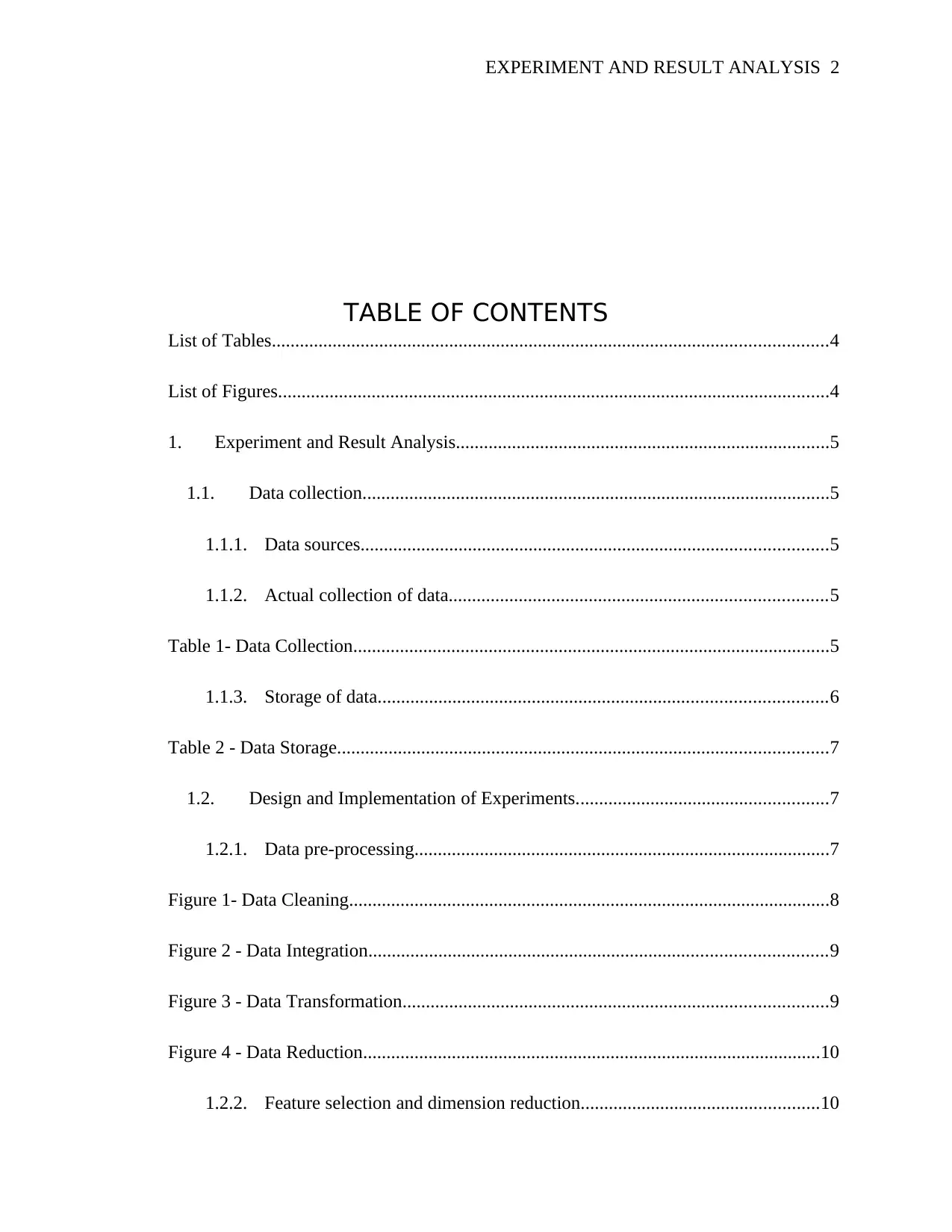
EXPERIMENT AND RESULT ANALYSIS 2
TABLE OF CONTENTS
List of Tables.......................................................................................................................4
List of Figures......................................................................................................................4
1. Experiment and Result Analysis................................................................................5
1.1. Data collection....................................................................................................5
1.1.1. Data sources....................................................................................................5
1.1.2. Actual collection of data.................................................................................5
Table 1- Data Collection......................................................................................................5
1.1.3. Storage of data................................................................................................6
Table 2 - Data Storage.........................................................................................................7
1.2. Design and Implementation of Experiments......................................................7
1.2.1. Data pre-processing.........................................................................................7
Figure 1- Data Cleaning.......................................................................................................8
Figure 2 - Data Integration..................................................................................................9
Figure 3 - Data Transformation...........................................................................................9
Figure 4 - Data Reduction..................................................................................................10
1.2.2. Feature selection and dimension reduction...................................................10
TABLE OF CONTENTS
List of Tables.......................................................................................................................4
List of Figures......................................................................................................................4
1. Experiment and Result Analysis................................................................................5
1.1. Data collection....................................................................................................5
1.1.1. Data sources....................................................................................................5
1.1.2. Actual collection of data.................................................................................5
Table 1- Data Collection......................................................................................................5
1.1.3. Storage of data................................................................................................6
Table 2 - Data Storage.........................................................................................................7
1.2. Design and Implementation of Experiments......................................................7
1.2.1. Data pre-processing.........................................................................................7
Figure 1- Data Cleaning.......................................................................................................8
Figure 2 - Data Integration..................................................................................................9
Figure 3 - Data Transformation...........................................................................................9
Figure 4 - Data Reduction..................................................................................................10
1.2.2. Feature selection and dimension reduction...................................................10
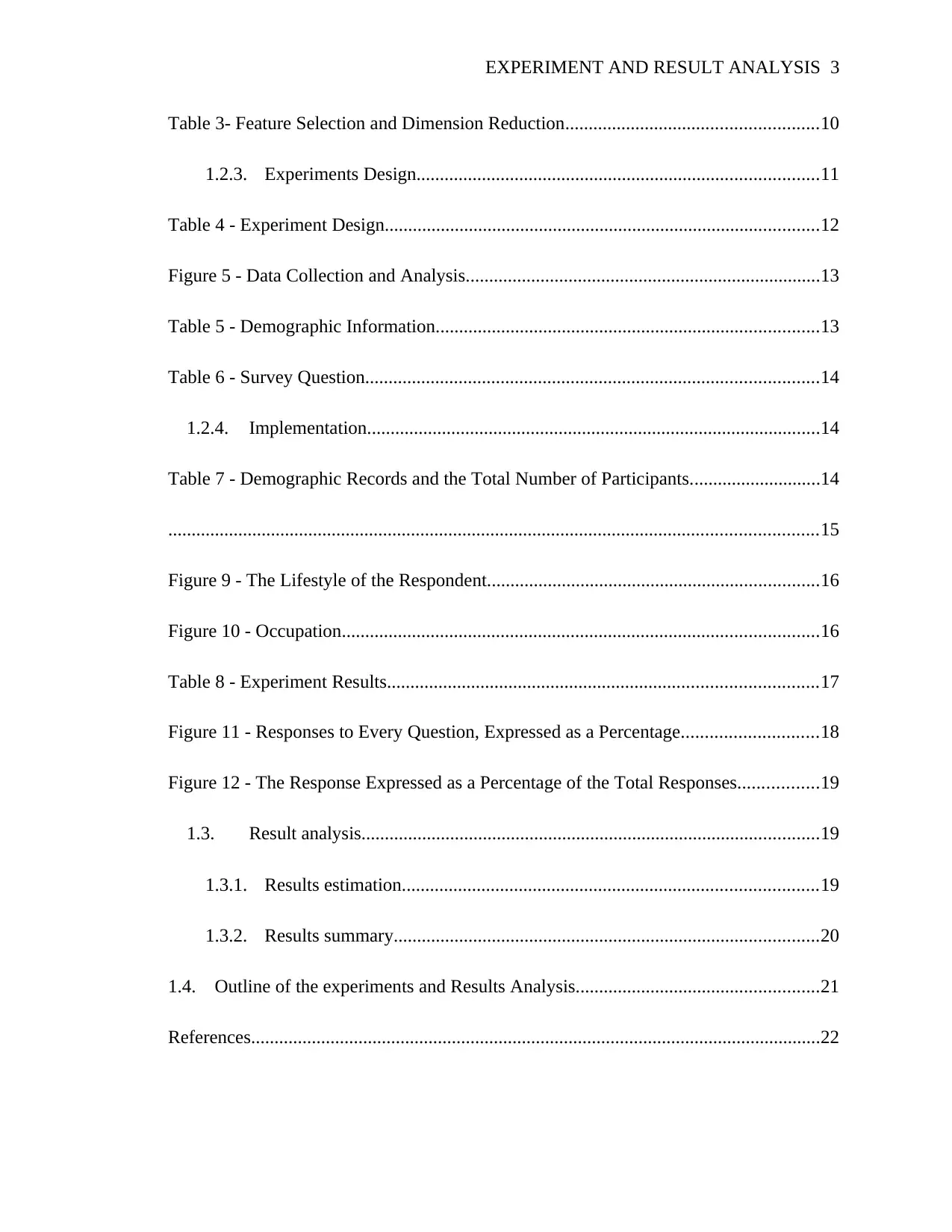
EXPERIMENT AND RESULT ANALYSIS 3
Table 3- Feature Selection and Dimension Reduction......................................................10
1.2.3. Experiments Design......................................................................................11
Table 4 - Experiment Design.............................................................................................12
Figure 5 - Data Collection and Analysis............................................................................13
Table 5 - Demographic Information..................................................................................13
Table 6 - Survey Question.................................................................................................14
1.2.4. Implementation.................................................................................................14
Table 7 - Demographic Records and the Total Number of Participants............................14
...........................................................................................................................................15
Figure 9 - The Lifestyle of the Respondent.......................................................................16
Figure 10 - Occupation......................................................................................................16
Table 8 - Experiment Results............................................................................................17
Figure 11 - Responses to Every Question, Expressed as a Percentage.............................18
Figure 12 - The Response Expressed as a Percentage of the Total Responses.................19
1.3. Result analysis..................................................................................................19
1.3.1. Results estimation.........................................................................................19
1.3.2. Results summary...........................................................................................20
1.4. Outline of the experiments and Results Analysis....................................................21
References..........................................................................................................................22
Table 3- Feature Selection and Dimension Reduction......................................................10
1.2.3. Experiments Design......................................................................................11
Table 4 - Experiment Design.............................................................................................12
Figure 5 - Data Collection and Analysis............................................................................13
Table 5 - Demographic Information..................................................................................13
Table 6 - Survey Question.................................................................................................14
1.2.4. Implementation.................................................................................................14
Table 7 - Demographic Records and the Total Number of Participants............................14
...........................................................................................................................................15
Figure 9 - The Lifestyle of the Respondent.......................................................................16
Figure 10 - Occupation......................................................................................................16
Table 8 - Experiment Results............................................................................................17
Figure 11 - Responses to Every Question, Expressed as a Percentage.............................18
Figure 12 - The Response Expressed as a Percentage of the Total Responses.................19
1.3. Result analysis..................................................................................................19
1.3.1. Results estimation.........................................................................................19
1.3.2. Results summary...........................................................................................20
1.4. Outline of the experiments and Results Analysis....................................................21
References..........................................................................................................................22
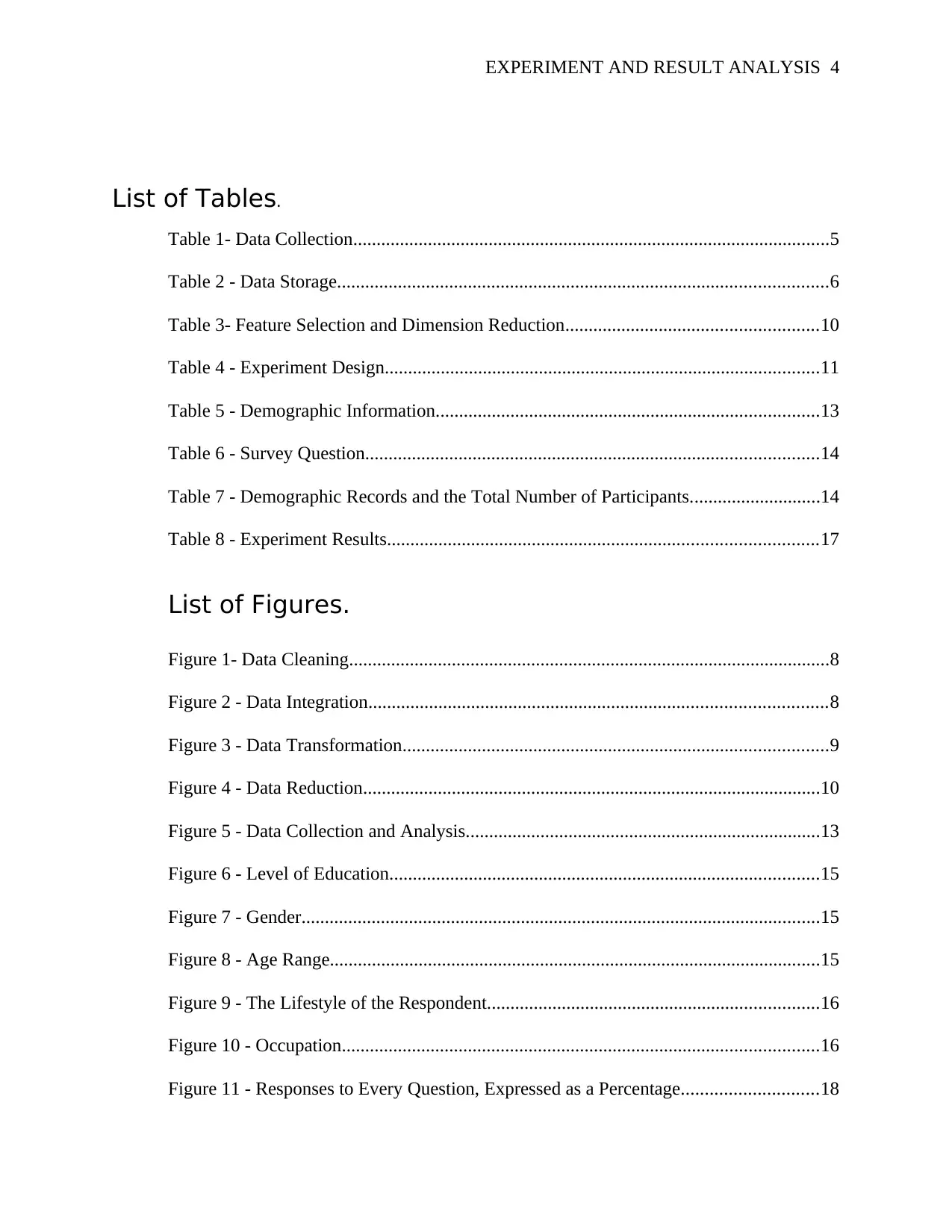
EXPERIMENT AND RESULT ANALYSIS 4
List of Tables.
Table 1- Data Collection......................................................................................................5
Table 2 - Data Storage.........................................................................................................6
Table 3- Feature Selection and Dimension Reduction......................................................10
Table 4 - Experiment Design.............................................................................................11
Table 5 - Demographic Information..................................................................................13
Table 6 - Survey Question.................................................................................................14
Table 7 - Demographic Records and the Total Number of Participants............................14
Table 8 - Experiment Results............................................................................................17
List of Figures.
Figure 1- Data Cleaning.......................................................................................................8
Figure 2 - Data Integration..................................................................................................8
Figure 3 - Data Transformation...........................................................................................9
Figure 4 - Data Reduction..................................................................................................10
Figure 5 - Data Collection and Analysis............................................................................13
Figure 6 - Level of Education............................................................................................15
Figure 7 - Gender...............................................................................................................15
Figure 8 - Age Range.........................................................................................................15
Figure 9 - The Lifestyle of the Respondent.......................................................................16
Figure 10 - Occupation......................................................................................................16
Figure 11 - Responses to Every Question, Expressed as a Percentage.............................18
List of Tables.
Table 1- Data Collection......................................................................................................5
Table 2 - Data Storage.........................................................................................................6
Table 3- Feature Selection and Dimension Reduction......................................................10
Table 4 - Experiment Design.............................................................................................11
Table 5 - Demographic Information..................................................................................13
Table 6 - Survey Question.................................................................................................14
Table 7 - Demographic Records and the Total Number of Participants............................14
Table 8 - Experiment Results............................................................................................17
List of Figures.
Figure 1- Data Cleaning.......................................................................................................8
Figure 2 - Data Integration..................................................................................................8
Figure 3 - Data Transformation...........................................................................................9
Figure 4 - Data Reduction..................................................................................................10
Figure 5 - Data Collection and Analysis............................................................................13
Figure 6 - Level of Education............................................................................................15
Figure 7 - Gender...............................................................................................................15
Figure 8 - Age Range.........................................................................................................15
Figure 9 - The Lifestyle of the Respondent.......................................................................16
Figure 10 - Occupation......................................................................................................16
Figure 11 - Responses to Every Question, Expressed as a Percentage.............................18
Secure Best Marks with AI Grader
Need help grading? Try our AI Grader for instant feedback on your assignments.
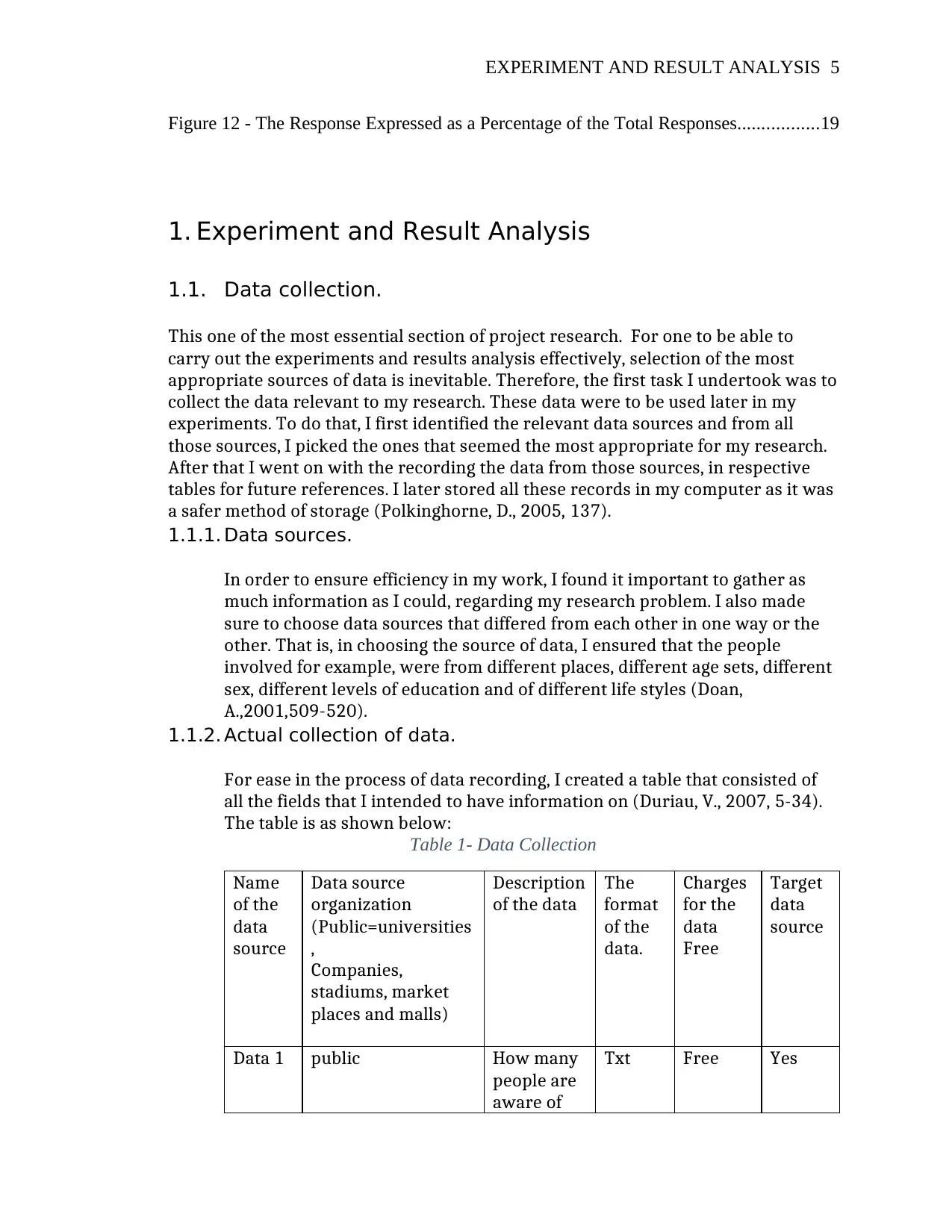
EXPERIMENT AND RESULT ANALYSIS 5
Figure 12 - The Response Expressed as a Percentage of the Total Responses.................19
1. Experiment and Result Analysis
1.1. Data collection.
This one of the most essential section of project research. For one to be able to
carry out the experiments and results analysis effectively, selection of the most
appropriate sources of data is inevitable. Therefore, the first task I undertook was to
collect the data relevant to my research. These data were to be used later in my
experiments. To do that, I first identified the relevant data sources and from all
those sources, I picked the ones that seemed the most appropriate for my research.
After that I went on with the recording the data from those sources, in respective
tables for future references. I later stored all these records in my computer as it was
a safer method of storage (Polkinghorne, D., 2005, 137).
1.1.1. Data sources.
In order to ensure efficiency in my work, I found it important to gather as
much information as I could, regarding my research problem. I also made
sure to choose data sources that differed from each other in one way or the
other. That is, in choosing the source of data, I ensured that the people
involved for example, were from different places, different age sets, different
sex, different levels of education and of different life styles (Doan,
A.,2001,509-520).
1.1.2. Actual collection of data.
For ease in the process of data recording, I created a table that consisted of
all the fields that I intended to have information on (Duriau, V., 2007, 5-34).
The table is as shown below:
Table 1- Data Collection
Name
of the
data
source
Data source
organization
(Public=universities
,
Companies,
stadiums, market
places and malls)
Description
of the data
The
format
of the
data.
Charges
for the
data
Free
Target
data
source
Data 1 public How many
people are
aware of
Txt Free Yes
Figure 12 - The Response Expressed as a Percentage of the Total Responses.................19
1. Experiment and Result Analysis
1.1. Data collection.
This one of the most essential section of project research. For one to be able to
carry out the experiments and results analysis effectively, selection of the most
appropriate sources of data is inevitable. Therefore, the first task I undertook was to
collect the data relevant to my research. These data were to be used later in my
experiments. To do that, I first identified the relevant data sources and from all
those sources, I picked the ones that seemed the most appropriate for my research.
After that I went on with the recording the data from those sources, in respective
tables for future references. I later stored all these records in my computer as it was
a safer method of storage (Polkinghorne, D., 2005, 137).
1.1.1. Data sources.
In order to ensure efficiency in my work, I found it important to gather as
much information as I could, regarding my research problem. I also made
sure to choose data sources that differed from each other in one way or the
other. That is, in choosing the source of data, I ensured that the people
involved for example, were from different places, different age sets, different
sex, different levels of education and of different life styles (Doan,
A.,2001,509-520).
1.1.2. Actual collection of data.
For ease in the process of data recording, I created a table that consisted of
all the fields that I intended to have information on (Duriau, V., 2007, 5-34).
The table is as shown below:
Table 1- Data Collection
Name
of the
data
source
Data source
organization
(Public=universities
,
Companies,
stadiums, market
places and malls)
Description
of the data
The
format
of the
data.
Charges
for the
data
Free
Target
data
source
Data 1 public How many
people are
aware of
Txt Free Yes
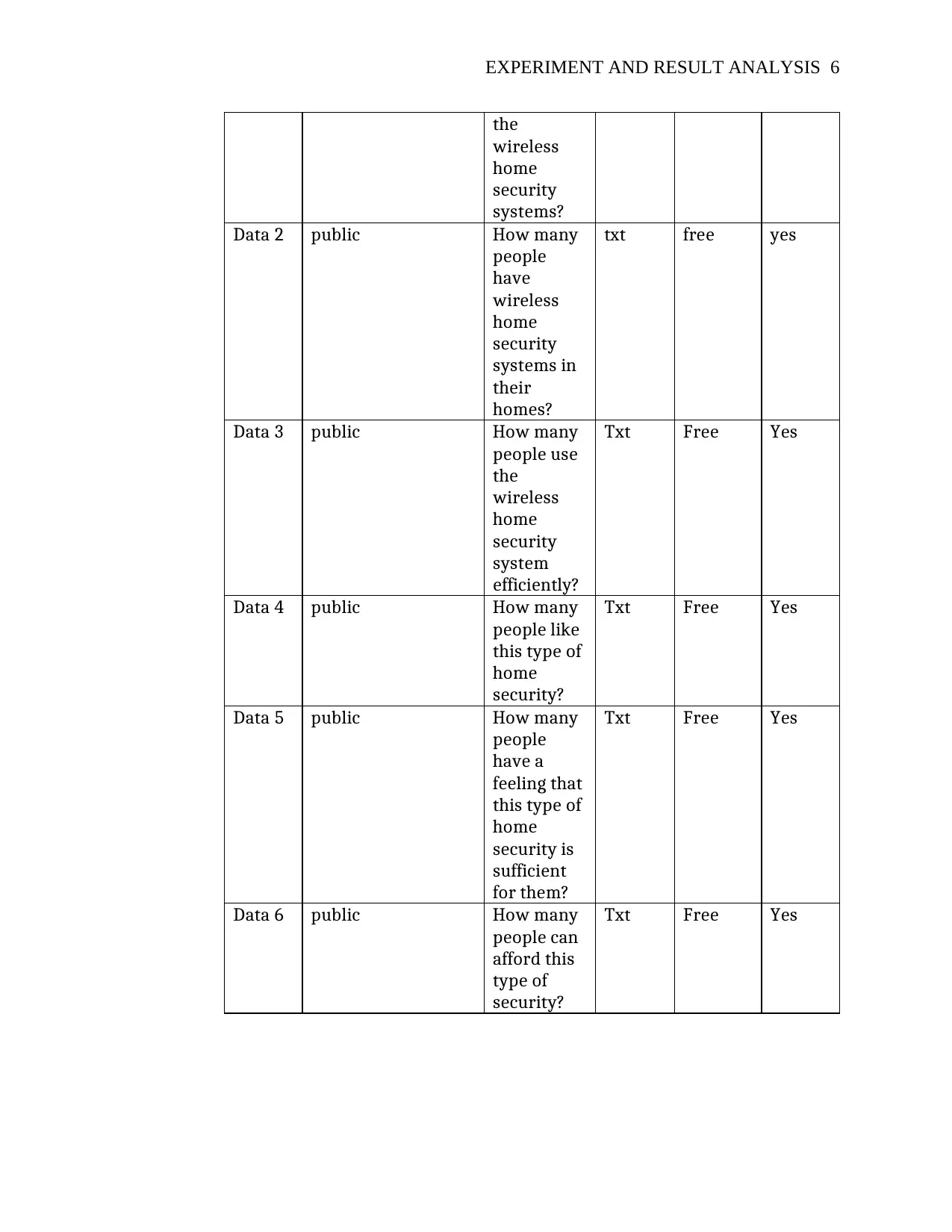
EXPERIMENT AND RESULT ANALYSIS 6
the
wireless
home
security
systems?
Data 2 public How many
people
have
wireless
home
security
systems in
their
homes?
txt free yes
Data 3 public How many
people use
the
wireless
home
security
system
efficiently?
Txt Free Yes
Data 4 public How many
people like
this type of
home
security?
Txt Free Yes
Data 5 public How many
people
have a
feeling that
this type of
home
security is
sufficient
for them?
Txt Free Yes
Data 6 public How many
people can
afford this
type of
security?
Txt Free Yes
the
wireless
home
security
systems?
Data 2 public How many
people
have
wireless
home
security
systems in
their
homes?
txt free yes
Data 3 public How many
people use
the
wireless
home
security
system
efficiently?
Txt Free Yes
Data 4 public How many
people like
this type of
home
security?
Txt Free Yes
Data 5 public How many
people
have a
feeling that
this type of
home
security is
sufficient
for them?
Txt Free Yes
Data 6 public How many
people can
afford this
type of
security?
Txt Free Yes
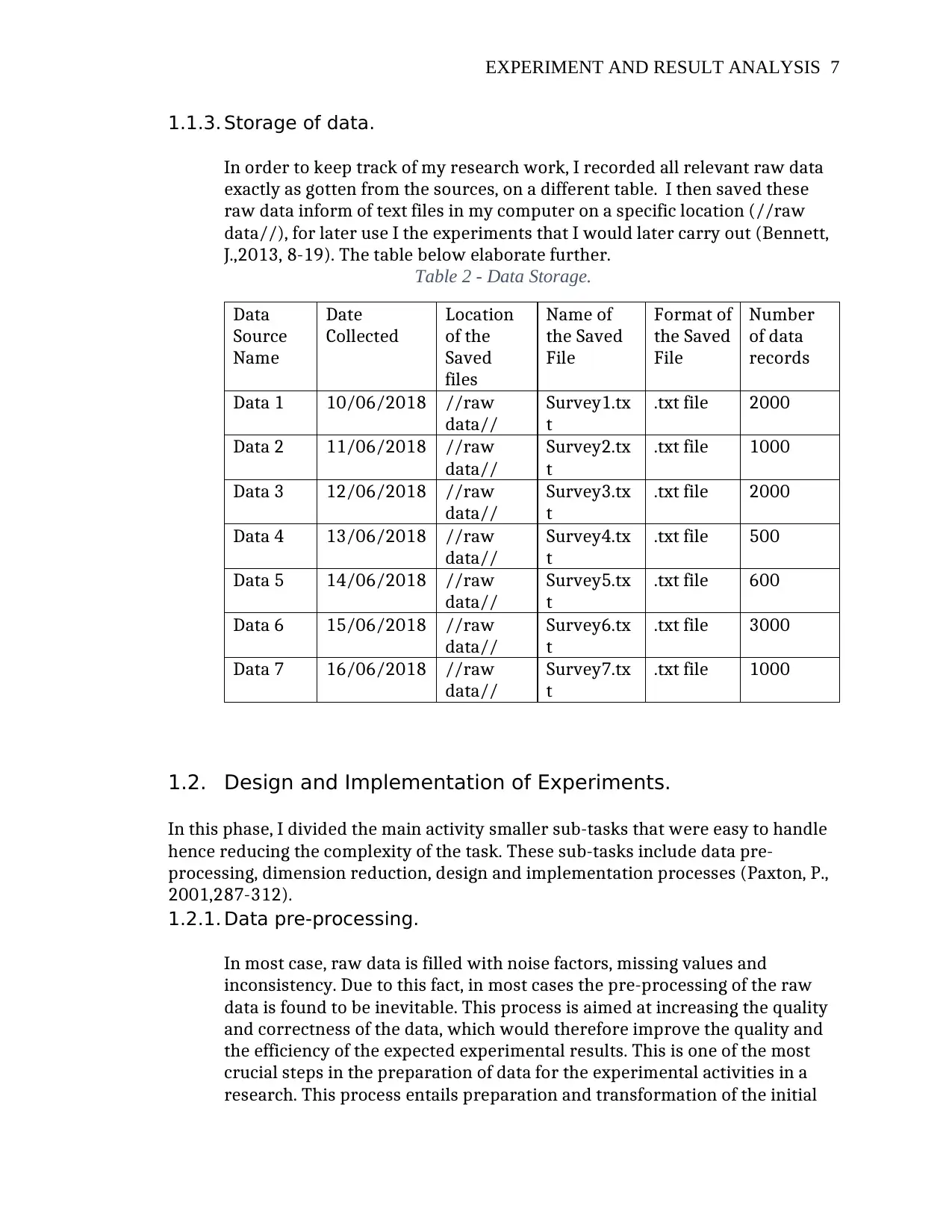
EXPERIMENT AND RESULT ANALYSIS 7
1.1.3. Storage of data.
In order to keep track of my research work, I recorded all relevant raw data
exactly as gotten from the sources, on a different table. I then saved these
raw data inform of text files in my computer on a specific location (//raw
data//), for later use I the experiments that I would later carry out (Bennett,
J.,2013, 8-19). The table below elaborate further.
Table 2 - Data Storage.
Data
Source
Name
Date
Collected
Location
of the
Saved
files
Name of
the Saved
File
Format of
the Saved
File
Number
of data
records
Data 1 10/06/2018 //raw
data//
Survey1.tx
t
.txt file 2000
Data 2 11/06/2018 //raw
data//
Survey2.tx
t
.txt file 1000
Data 3 12/06/2018 //raw
data//
Survey3.tx
t
.txt file 2000
Data 4 13/06/2018 //raw
data//
Survey4.tx
t
.txt file 500
Data 5 14/06/2018 //raw
data//
Survey5.tx
t
.txt file 600
Data 6 15/06/2018 //raw
data//
Survey6.tx
t
.txt file 3000
Data 7 16/06/2018 //raw
data//
Survey7.tx
t
.txt file 1000
1.2. Design and Implementation of Experiments.
In this phase, I divided the main activity smaller sub-tasks that were easy to handle
hence reducing the complexity of the task. These sub-tasks include data pre-
processing, dimension reduction, design and implementation processes (Paxton, P.,
2001,287-312).
1.2.1. Data pre-processing.
In most case, raw data is filled with noise factors, missing values and
inconsistency. Due to this fact, in most cases the pre-processing of the raw
data is found to be inevitable. This process is aimed at increasing the quality
and correctness of the data, which would therefore improve the quality and
the efficiency of the expected experimental results. This is one of the most
crucial steps in the preparation of data for the experimental activities in a
research. This process entails preparation and transformation of the initial
1.1.3. Storage of data.
In order to keep track of my research work, I recorded all relevant raw data
exactly as gotten from the sources, on a different table. I then saved these
raw data inform of text files in my computer on a specific location (//raw
data//), for later use I the experiments that I would later carry out (Bennett,
J.,2013, 8-19). The table below elaborate further.
Table 2 - Data Storage.
Data
Source
Name
Date
Collected
Location
of the
Saved
files
Name of
the Saved
File
Format of
the Saved
File
Number
of data
records
Data 1 10/06/2018 //raw
data//
Survey1.tx
t
.txt file 2000
Data 2 11/06/2018 //raw
data//
Survey2.tx
t
.txt file 1000
Data 3 12/06/2018 //raw
data//
Survey3.tx
t
.txt file 2000
Data 4 13/06/2018 //raw
data//
Survey4.tx
t
.txt file 500
Data 5 14/06/2018 //raw
data//
Survey5.tx
t
.txt file 600
Data 6 15/06/2018 //raw
data//
Survey6.tx
t
.txt file 3000
Data 7 16/06/2018 //raw
data//
Survey7.tx
t
.txt file 1000
1.2. Design and Implementation of Experiments.
In this phase, I divided the main activity smaller sub-tasks that were easy to handle
hence reducing the complexity of the task. These sub-tasks include data pre-
processing, dimension reduction, design and implementation processes (Paxton, P.,
2001,287-312).
1.2.1. Data pre-processing.
In most case, raw data is filled with noise factors, missing values and
inconsistency. Due to this fact, in most cases the pre-processing of the raw
data is found to be inevitable. This process is aimed at increasing the quality
and correctness of the data, which would therefore improve the quality and
the efficiency of the expected experimental results. This is one of the most
crucial steps in the preparation of data for the experimental activities in a
research. This process entails preparation and transformation of the initial
Paraphrase This Document
Need a fresh take? Get an instant paraphrase of this document with our AI Paraphraser
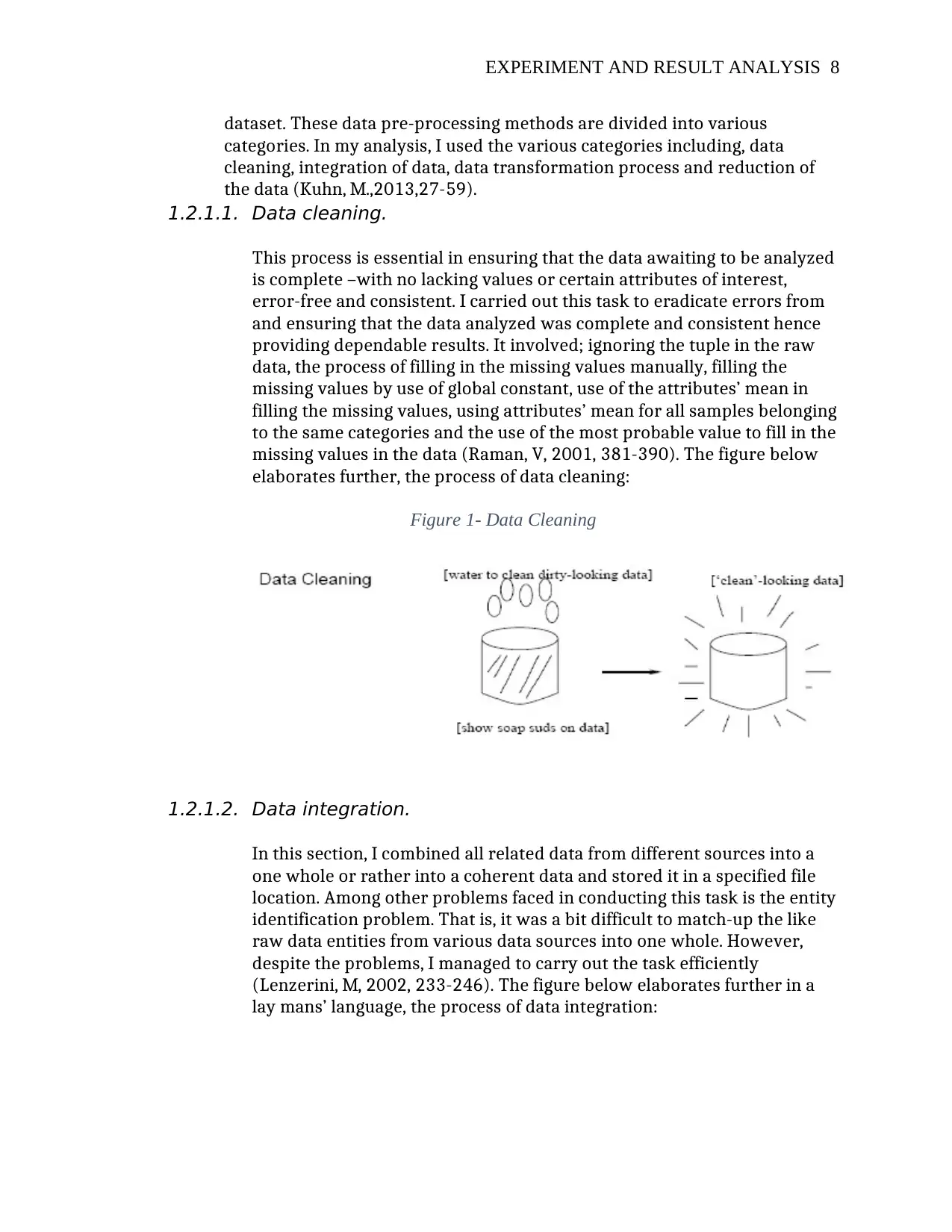
EXPERIMENT AND RESULT ANALYSIS 8
dataset. These data pre-processing methods are divided into various
categories. In my analysis, I used the various categories including, data
cleaning, integration of data, data transformation process and reduction of
the data (Kuhn, M.,2013,27-59).
1.2.1.1. Data cleaning.
This process is essential in ensuring that the data awaiting to be analyzed
is complete –with no lacking values or certain attributes of interest,
error-free and consistent. I carried out this task to eradicate errors from
and ensuring that the data analyzed was complete and consistent hence
providing dependable results. It involved; ignoring the tuple in the raw
data, the process of filling in the missing values manually, filling the
missing values by use of global constant, use of the attributes’ mean in
filling the missing values, using attributes’ mean for all samples belonging
to the same categories and the use of the most probable value to fill in the
missing values in the data (Raman, V, 2001, 381-390). The figure below
elaborates further, the process of data cleaning:
Figure 1- Data Cleaning
1.2.1.2. Data integration.
In this section, I combined all related data from different sources into a
one whole or rather into a coherent data and stored it in a specified file
location. Among other problems faced in conducting this task is the entity
identification problem. That is, it was a bit difficult to match-up the like
raw data entities from various data sources into one whole. However,
despite the problems, I managed to carry out the task efficiently
(Lenzerini, M, 2002, 233-246). The figure below elaborates further in a
lay mans’ language, the process of data integration:
dataset. These data pre-processing methods are divided into various
categories. In my analysis, I used the various categories including, data
cleaning, integration of data, data transformation process and reduction of
the data (Kuhn, M.,2013,27-59).
1.2.1.1. Data cleaning.
This process is essential in ensuring that the data awaiting to be analyzed
is complete –with no lacking values or certain attributes of interest,
error-free and consistent. I carried out this task to eradicate errors from
and ensuring that the data analyzed was complete and consistent hence
providing dependable results. It involved; ignoring the tuple in the raw
data, the process of filling in the missing values manually, filling the
missing values by use of global constant, use of the attributes’ mean in
filling the missing values, using attributes’ mean for all samples belonging
to the same categories and the use of the most probable value to fill in the
missing values in the data (Raman, V, 2001, 381-390). The figure below
elaborates further, the process of data cleaning:
Figure 1- Data Cleaning
1.2.1.2. Data integration.
In this section, I combined all related data from different sources into a
one whole or rather into a coherent data and stored it in a specified file
location. Among other problems faced in conducting this task is the entity
identification problem. That is, it was a bit difficult to match-up the like
raw data entities from various data sources into one whole. However,
despite the problems, I managed to carry out the task efficiently
(Lenzerini, M, 2002, 233-246). The figure below elaborates further in a
lay mans’ language, the process of data integration:
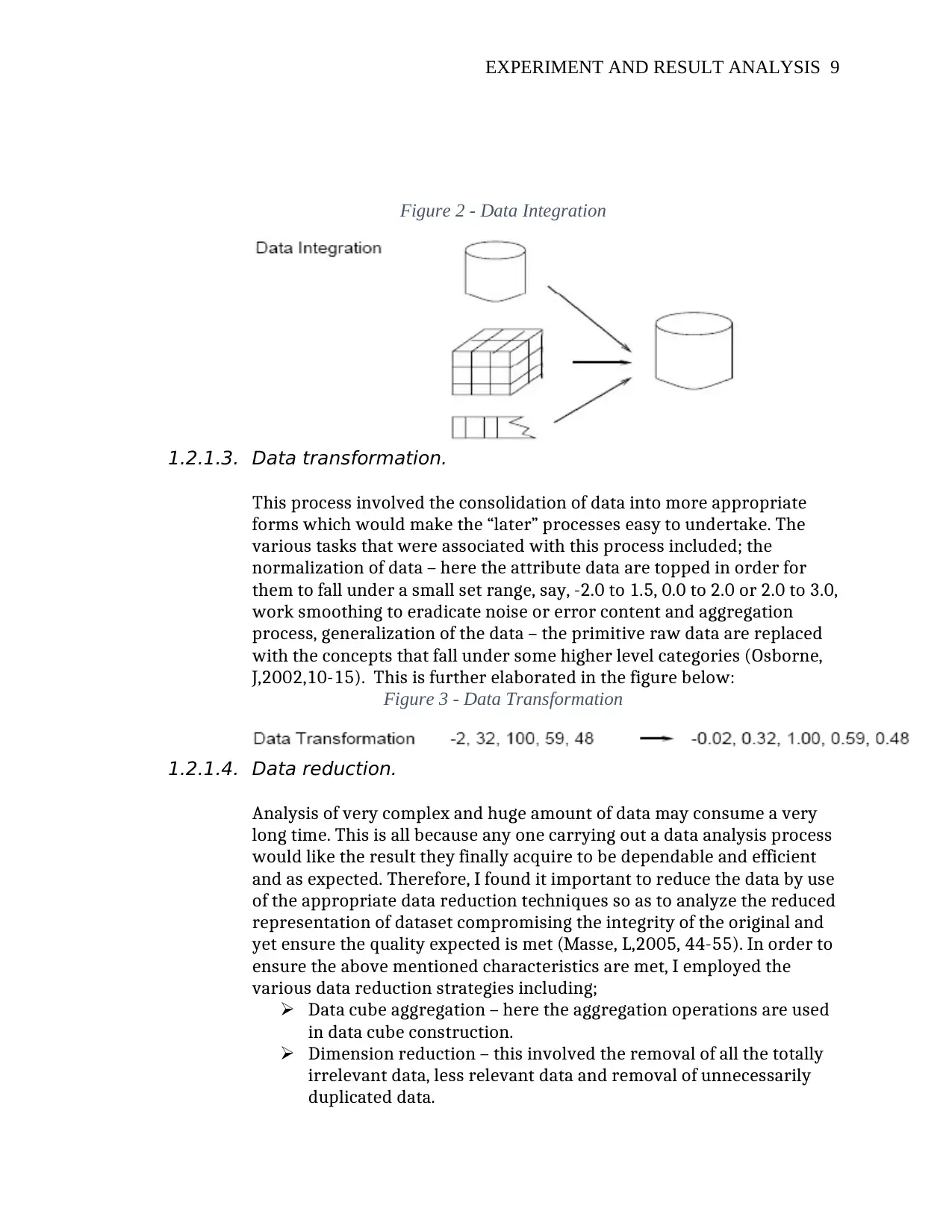
EXPERIMENT AND RESULT ANALYSIS 9
Figure 2 - Data Integration
1.2.1.3. Data transformation.
This process involved the consolidation of data into more appropriate
forms which would make the “later” processes easy to undertake. The
various tasks that were associated with this process included; the
normalization of data – here the attribute data are topped in order for
them to fall under a small set range, say, -2.0 to 1.5, 0.0 to 2.0 or 2.0 to 3.0,
work smoothing to eradicate noise or error content and aggregation
process, generalization of the data – the primitive raw data are replaced
with the concepts that fall under some higher level categories (Osborne,
J,2002,10-15). This is further elaborated in the figure below:
Figure 3 - Data Transformation
1.2.1.4. Data reduction.
Analysis of very complex and huge amount of data may consume a very
long time. This is all because any one carrying out a data analysis process
would like the result they finally acquire to be dependable and efficient
and as expected. Therefore, I found it important to reduce the data by use
of the appropriate data reduction techniques so as to analyze the reduced
representation of dataset compromising the integrity of the original and
yet ensure the quality expected is met (Masse, L,2005, 44-55). In order to
ensure the above mentioned characteristics are met, I employed the
various data reduction strategies including;
Data cube aggregation – here the aggregation operations are used
in data cube construction.
Dimension reduction – this involved the removal of all the totally
irrelevant data, less relevant data and removal of unnecessarily
duplicated data.
Figure 2 - Data Integration
1.2.1.3. Data transformation.
This process involved the consolidation of data into more appropriate
forms which would make the “later” processes easy to undertake. The
various tasks that were associated with this process included; the
normalization of data – here the attribute data are topped in order for
them to fall under a small set range, say, -2.0 to 1.5, 0.0 to 2.0 or 2.0 to 3.0,
work smoothing to eradicate noise or error content and aggregation
process, generalization of the data – the primitive raw data are replaced
with the concepts that fall under some higher level categories (Osborne,
J,2002,10-15). This is further elaborated in the figure below:
Figure 3 - Data Transformation
1.2.1.4. Data reduction.
Analysis of very complex and huge amount of data may consume a very
long time. This is all because any one carrying out a data analysis process
would like the result they finally acquire to be dependable and efficient
and as expected. Therefore, I found it important to reduce the data by use
of the appropriate data reduction techniques so as to analyze the reduced
representation of dataset compromising the integrity of the original and
yet ensure the quality expected is met (Masse, L,2005, 44-55). In order to
ensure the above mentioned characteristics are met, I employed the
various data reduction strategies including;
Data cube aggregation – here the aggregation operations are used
in data cube construction.
Dimension reduction – this involved the removal of all the totally
irrelevant data, less relevant data and removal of unnecessarily
duplicated data.
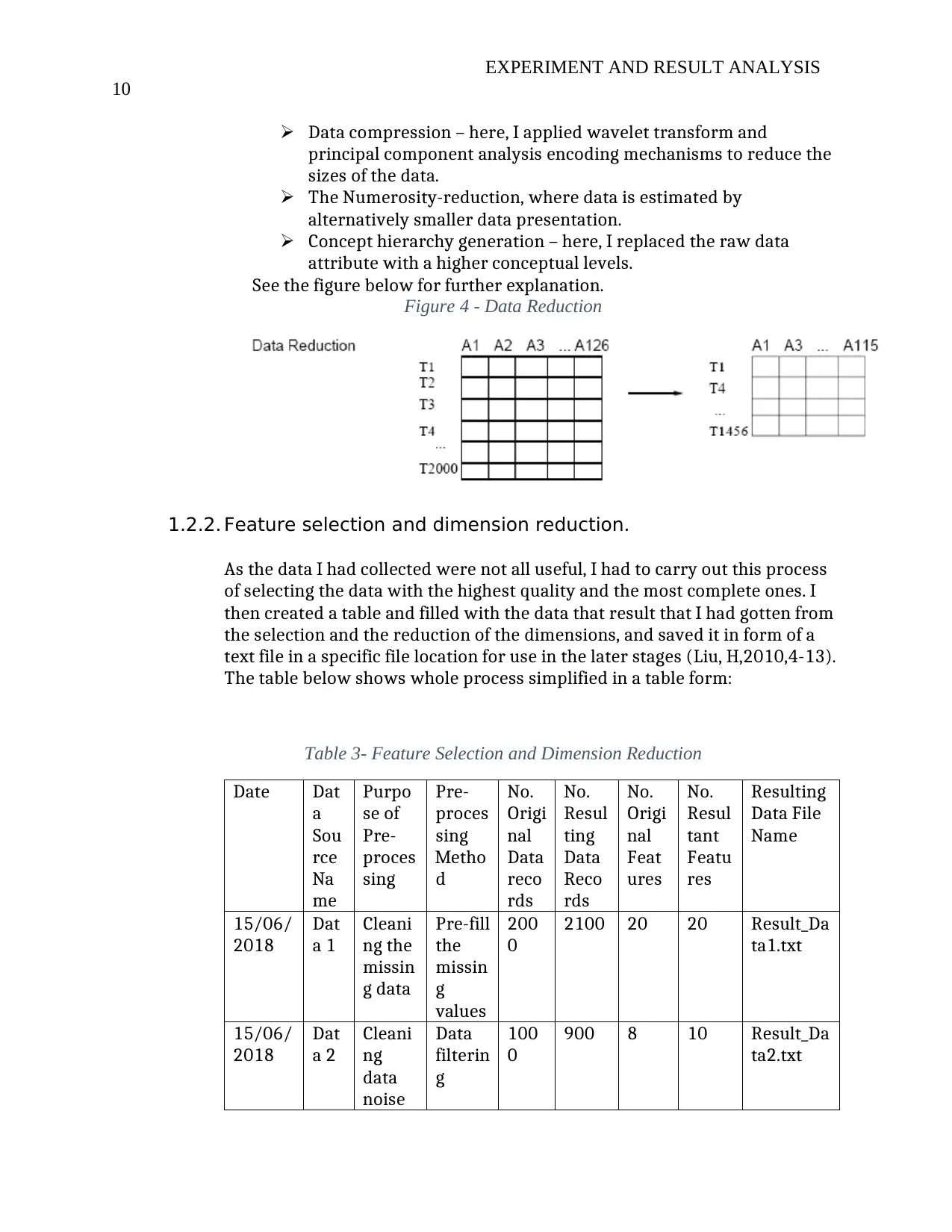
EXPERIMENT AND RESULT ANALYSIS
10
Data compression – here, I applied wavelet transform and
principal component analysis encoding mechanisms to reduce the
sizes of the data.
The Numerosity-reduction, where data is estimated by
alternatively smaller data presentation.
Concept hierarchy generation – here, I replaced the raw data
attribute with a higher conceptual levels.
See the figure below for further explanation.
Figure 4 - Data Reduction
1.2.2. Feature selection and dimension reduction.
As the data I had collected were not all useful, I had to carry out this process
of selecting the data with the highest quality and the most complete ones. I
then created a table and filled with the data that result that I had gotten from
the selection and the reduction of the dimensions, and saved it in form of a
text file in a specific file location for use in the later stages (Liu, H,2010,4-13).
The table below shows whole process simplified in a table form:
Table 3- Feature Selection and Dimension Reduction
Date Dat
a
Sou
rce
Na
me
Purpo
se of
Pre-
proces
sing
Pre-
proces
sing
Metho
d
No.
Origi
nal
Data
reco
rds
No.
Resul
ting
Data
Reco
rds
No.
Origi
nal
Feat
ures
No.
Resul
tant
Featu
res
Resulting
Data File
Name
15/06/
2018
Dat
a 1
Cleani
ng the
missin
g data
Pre-fill
the
missin
g
values
200
0
2100 20 20 Result_Da
ta1.txt
15/06/
2018
Dat
a 2
Cleani
ng
data
noise
Data
filterin
g
100
0
900 8 10 Result_Da
ta2.txt
10
Data compression – here, I applied wavelet transform and
principal component analysis encoding mechanisms to reduce the
sizes of the data.
The Numerosity-reduction, where data is estimated by
alternatively smaller data presentation.
Concept hierarchy generation – here, I replaced the raw data
attribute with a higher conceptual levels.
See the figure below for further explanation.
Figure 4 - Data Reduction
1.2.2. Feature selection and dimension reduction.
As the data I had collected were not all useful, I had to carry out this process
of selecting the data with the highest quality and the most complete ones. I
then created a table and filled with the data that result that I had gotten from
the selection and the reduction of the dimensions, and saved it in form of a
text file in a specific file location for use in the later stages (Liu, H,2010,4-13).
The table below shows whole process simplified in a table form:
Table 3- Feature Selection and Dimension Reduction
Date Dat
a
Sou
rce
Na
me
Purpo
se of
Pre-
proces
sing
Pre-
proces
sing
Metho
d
No.
Origi
nal
Data
reco
rds
No.
Resul
ting
Data
Reco
rds
No.
Origi
nal
Feat
ures
No.
Resul
tant
Featu
res
Resulting
Data File
Name
15/06/
2018
Dat
a 1
Cleani
ng the
missin
g data
Pre-fill
the
missin
g
values
200
0
2100 20 20 Result_Da
ta1.txt
15/06/
2018
Dat
a 2
Cleani
ng
data
noise
Data
filterin
g
100
0
900 8 10 Result_Da
ta2.txt
Secure Best Marks with AI Grader
Need help grading? Try our AI Grader for instant feedback on your assignments.
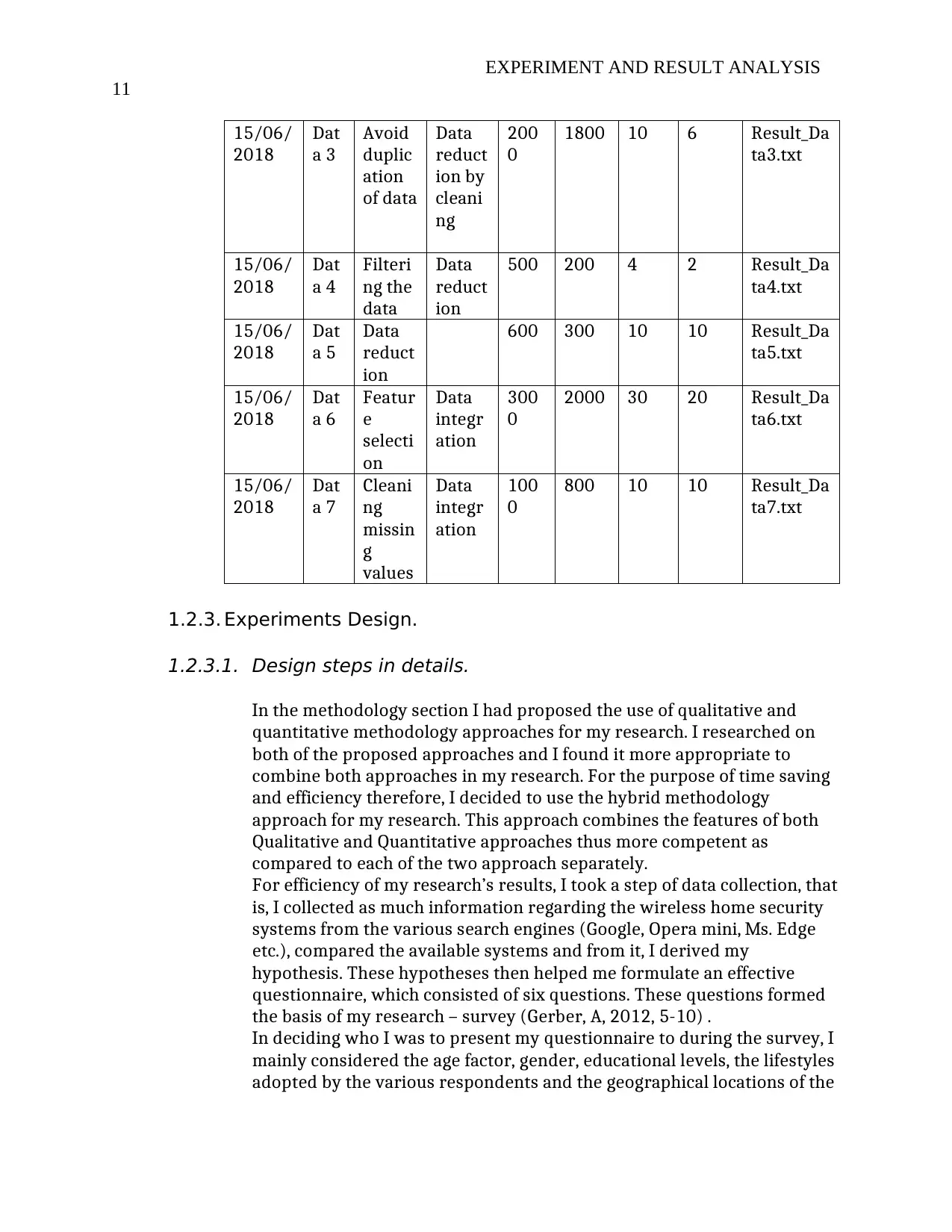
EXPERIMENT AND RESULT ANALYSIS
11
15/06/
2018
Dat
a 3
Avoid
duplic
ation
of data
Data
reduct
ion by
cleani
ng
200
0
1800 10 6 Result_Da
ta3.txt
15/06/
2018
Dat
a 4
Filteri
ng the
data
Data
reduct
ion
500 200 4 2 Result_Da
ta4.txt
15/06/
2018
Dat
a 5
Data
reduct
ion
600 300 10 10 Result_Da
ta5.txt
15/06/
2018
Dat
a 6
Featur
e
selecti
on
Data
integr
ation
300
0
2000 30 20 Result_Da
ta6.txt
15/06/
2018
Dat
a 7
Cleani
ng
missin
g
values
Data
integr
ation
100
0
800 10 10 Result_Da
ta7.txt
1.2.3. Experiments Design.
1.2.3.1. Design steps in details.
In the methodology section I had proposed the use of qualitative and
quantitative methodology approaches for my research. I researched on
both of the proposed approaches and I found it more appropriate to
combine both approaches in my research. For the purpose of time saving
and efficiency therefore, I decided to use the hybrid methodology
approach for my research. This approach combines the features of both
Qualitative and Quantitative approaches thus more competent as
compared to each of the two approach separately.
For efficiency of my research’s results, I took a step of data collection, that
is, I collected as much information regarding the wireless home security
systems from the various search engines (Google, Opera mini, Ms. Edge
etc.), compared the available systems and from it, I derived my
hypothesis. These hypotheses then helped me formulate an effective
questionnaire, which consisted of six questions. These questions formed
the basis of my research – survey (Gerber, A, 2012, 5-10) .
In deciding who I was to present my questionnaire to during the survey, I
mainly considered the age factor, gender, educational levels, the lifestyles
adopted by the various respondents and the geographical locations of the
11
15/06/
2018
Dat
a 3
Avoid
duplic
ation
of data
Data
reduct
ion by
cleani
ng
200
0
1800 10 6 Result_Da
ta3.txt
15/06/
2018
Dat
a 4
Filteri
ng the
data
Data
reduct
ion
500 200 4 2 Result_Da
ta4.txt
15/06/
2018
Dat
a 5
Data
reduct
ion
600 300 10 10 Result_Da
ta5.txt
15/06/
2018
Dat
a 6
Featur
e
selecti
on
Data
integr
ation
300
0
2000 30 20 Result_Da
ta6.txt
15/06/
2018
Dat
a 7
Cleani
ng
missin
g
values
Data
integr
ation
100
0
800 10 10 Result_Da
ta7.txt
1.2.3. Experiments Design.
1.2.3.1. Design steps in details.
In the methodology section I had proposed the use of qualitative and
quantitative methodology approaches for my research. I researched on
both of the proposed approaches and I found it more appropriate to
combine both approaches in my research. For the purpose of time saving
and efficiency therefore, I decided to use the hybrid methodology
approach for my research. This approach combines the features of both
Qualitative and Quantitative approaches thus more competent as
compared to each of the two approach separately.
For efficiency of my research’s results, I took a step of data collection, that
is, I collected as much information regarding the wireless home security
systems from the various search engines (Google, Opera mini, Ms. Edge
etc.), compared the available systems and from it, I derived my
hypothesis. These hypotheses then helped me formulate an effective
questionnaire, which consisted of six questions. These questions formed
the basis of my research – survey (Gerber, A, 2012, 5-10) .
In deciding who I was to present my questionnaire to during the survey, I
mainly considered the age factor, gender, educational levels, the lifestyles
adopted by the various respondents and the geographical locations of the
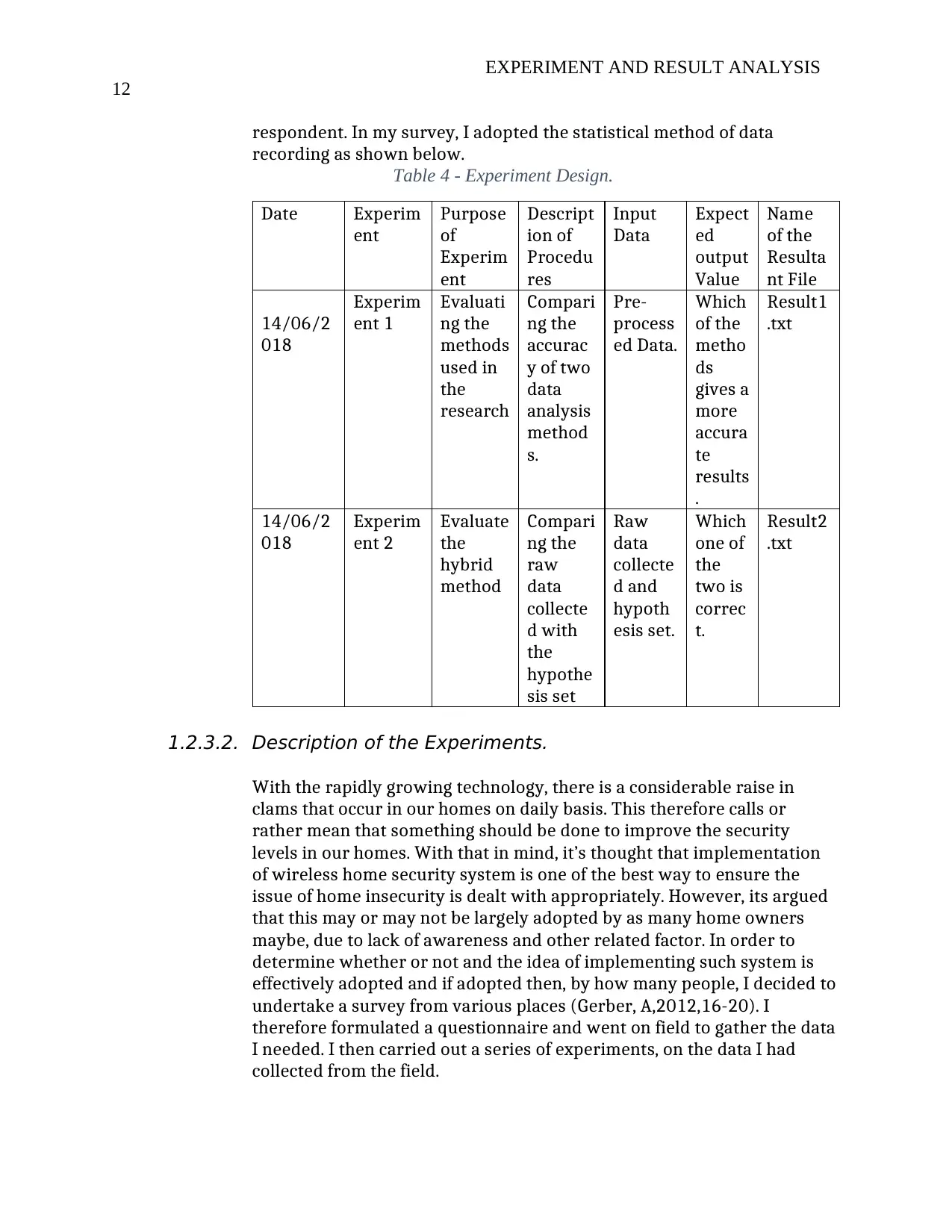
EXPERIMENT AND RESULT ANALYSIS
12
respondent. In my survey, I adopted the statistical method of data
recording as shown below.
Table 4 - Experiment Design.
Date Experim
ent
Purpose
of
Experim
ent
Descript
ion of
Procedu
res
Input
Data
Expect
ed
output
Value
Name
of the
Resulta
nt File
14/06/2
018
Experim
ent 1
Evaluati
ng the
methods
used in
the
research
Compari
ng the
accurac
y of two
data
analysis
method
s.
Pre-
process
ed Data.
Which
of the
metho
ds
gives a
more
accura
te
results
.
Result1
.txt
14/06/2
018
Experim
ent 2
Evaluate
the
hybrid
method
Compari
ng the
raw
data
collecte
d with
the
hypothe
sis set
Raw
data
collecte
d and
hypoth
esis set.
Which
one of
the
two is
correc
t.
Result2
.txt
1.2.3.2. Description of the Experiments.
With the rapidly growing technology, there is a considerable raise in
clams that occur in our homes on daily basis. This therefore calls or
rather mean that something should be done to improve the security
levels in our homes. With that in mind, it’s thought that implementation
of wireless home security system is one of the best way to ensure the
issue of home insecurity is dealt with appropriately. However, its argued
that this may or may not be largely adopted by as many home owners
maybe, due to lack of awareness and other related factor. In order to
determine whether or not and the idea of implementing such system is
effectively adopted and if adopted then, by how many people, I decided to
undertake a survey from various places (Gerber, A,2012,16-20). I
therefore formulated a questionnaire and went on field to gather the data
I needed. I then carried out a series of experiments, on the data I had
collected from the field.
12
respondent. In my survey, I adopted the statistical method of data
recording as shown below.
Table 4 - Experiment Design.
Date Experim
ent
Purpose
of
Experim
ent
Descript
ion of
Procedu
res
Input
Data
Expect
ed
output
Value
Name
of the
Resulta
nt File
14/06/2
018
Experim
ent 1
Evaluati
ng the
methods
used in
the
research
Compari
ng the
accurac
y of two
data
analysis
method
s.
Pre-
process
ed Data.
Which
of the
metho
ds
gives a
more
accura
te
results
.
Result1
.txt
14/06/2
018
Experim
ent 2
Evaluate
the
hybrid
method
Compari
ng the
raw
data
collecte
d with
the
hypothe
sis set
Raw
data
collecte
d and
hypoth
esis set.
Which
one of
the
two is
correc
t.
Result2
.txt
1.2.3.2. Description of the Experiments.
With the rapidly growing technology, there is a considerable raise in
clams that occur in our homes on daily basis. This therefore calls or
rather mean that something should be done to improve the security
levels in our homes. With that in mind, it’s thought that implementation
of wireless home security system is one of the best way to ensure the
issue of home insecurity is dealt with appropriately. However, its argued
that this may or may not be largely adopted by as many home owners
maybe, due to lack of awareness and other related factor. In order to
determine whether or not and the idea of implementing such system is
effectively adopted and if adopted then, by how many people, I decided to
undertake a survey from various places (Gerber, A,2012,16-20). I
therefore formulated a questionnaire and went on field to gather the data
I needed. I then carried out a series of experiments, on the data I had
collected from the field.
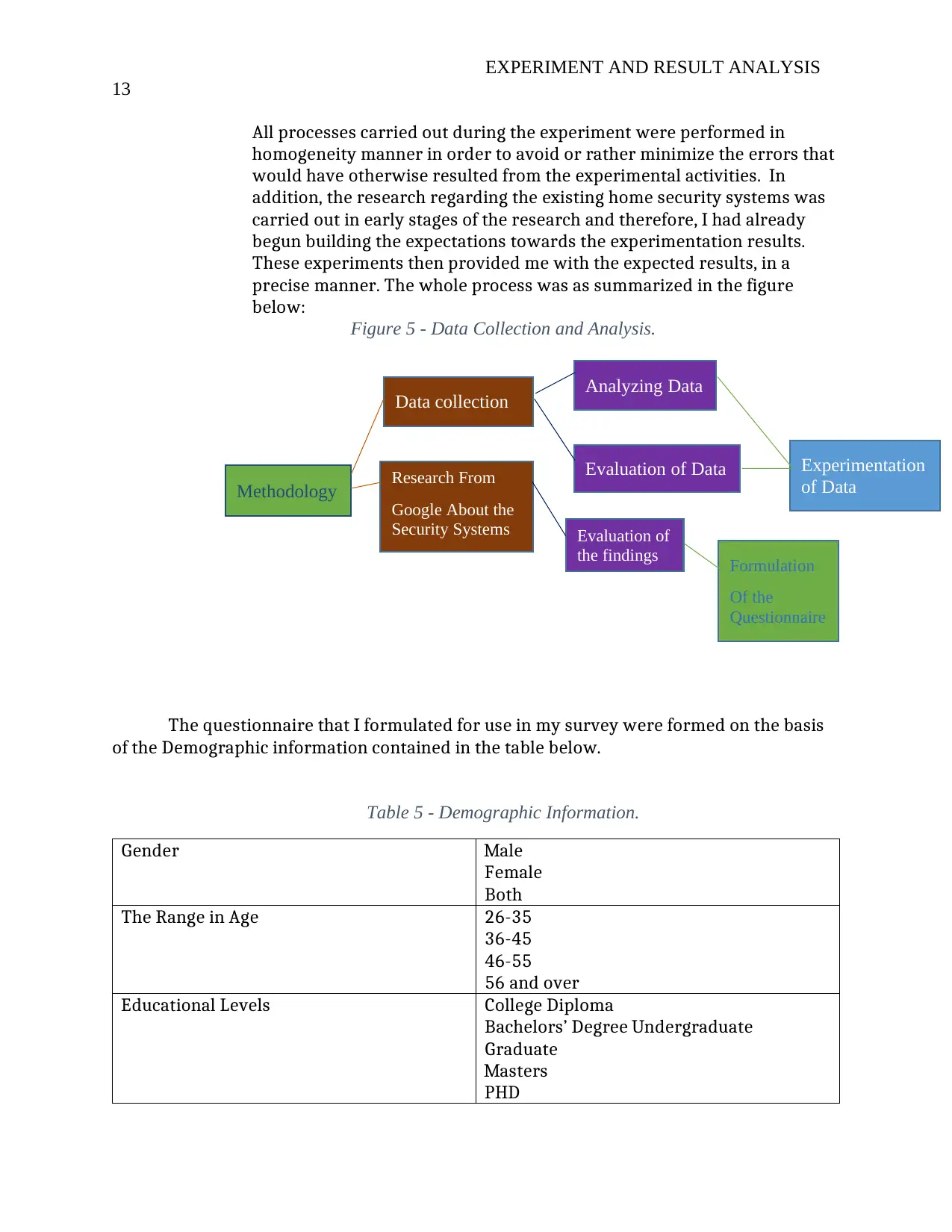
EXPERIMENT AND RESULT ANALYSIS
13
All processes carried out during the experiment were performed in
homogeneity manner in order to avoid or rather minimize the errors that
would have otherwise resulted from the experimental activities. In
addition, the research regarding the existing home security systems was
carried out in early stages of the research and therefore, I had already
begun building the expectations towards the experimentation results.
These experiments then provided me with the expected results, in a
precise manner. The whole process was as summarized in the figure
below:
Figure 5 - Data Collection and Analysis.
The questionnaire that I formulated for use in my survey were formed on the basis
of the Demographic information contained in the table below.
Table 5 - Demographic Information.
Gender Male
Female
Both
The Range in Age 26-35
36-45
46-55
56 and over
Educational Levels College Diploma
Bachelors’ Degree Undergraduate
Graduate
Masters
PHD
Analyzing Data
Formulation
Of the
Questionnaire
Evaluation of Data
Evaluation of
the findings
Data collection
Research From
Google About the
Security Systems
Experimentation
of DataMethodology
13
All processes carried out during the experiment were performed in
homogeneity manner in order to avoid or rather minimize the errors that
would have otherwise resulted from the experimental activities. In
addition, the research regarding the existing home security systems was
carried out in early stages of the research and therefore, I had already
begun building the expectations towards the experimentation results.
These experiments then provided me with the expected results, in a
precise manner. The whole process was as summarized in the figure
below:
Figure 5 - Data Collection and Analysis.
The questionnaire that I formulated for use in my survey were formed on the basis
of the Demographic information contained in the table below.
Table 5 - Demographic Information.
Gender Male
Female
Both
The Range in Age 26-35
36-45
46-55
56 and over
Educational Levels College Diploma
Bachelors’ Degree Undergraduate
Graduate
Masters
PHD
Analyzing Data
Formulation
Of the
Questionnaire
Evaluation of Data
Evaluation of
the findings
Data collection
Research From
Google About the
Security Systems
Experimentation
of DataMethodology
Paraphrase This Document
Need a fresh take? Get an instant paraphrase of this document with our AI Paraphraser
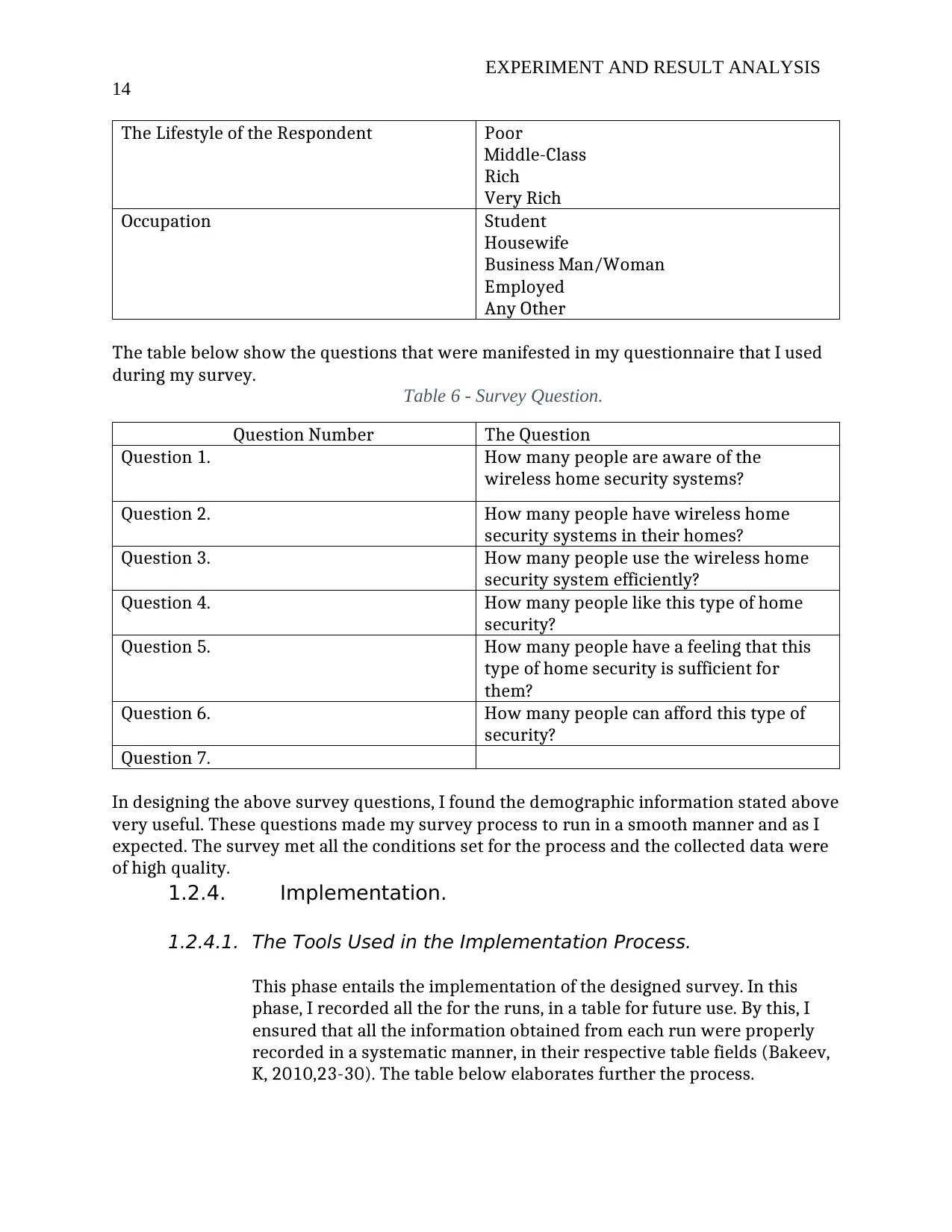
EXPERIMENT AND RESULT ANALYSIS
14
The Lifestyle of the Respondent Poor
Middle-Class
Rich
Very Rich
Occupation Student
Housewife
Business Man/Woman
Employed
Any Other
The table below show the questions that were manifested in my questionnaire that I used
during my survey.
Table 6 - Survey Question.
Question Number The Question
Question 1. How many people are aware of the
wireless home security systems?
Question 2. How many people have wireless home
security systems in their homes?
Question 3. How many people use the wireless home
security system efficiently?
Question 4. How many people like this type of home
security?
Question 5. How many people have a feeling that this
type of home security is sufficient for
them?
Question 6. How many people can afford this type of
security?
Question 7.
In designing the above survey questions, I found the demographic information stated above
very useful. These questions made my survey process to run in a smooth manner and as I
expected. The survey met all the conditions set for the process and the collected data were
of high quality.
1.2.4. Implementation.
1.2.4.1. The Tools Used in the Implementation Process.
This phase entails the implementation of the designed survey. In this
phase, I recorded all the for the runs, in a table for future use. By this, I
ensured that all the information obtained from each run were properly
recorded in a systematic manner, in their respective table fields (Bakeev,
K, 2010,23-30). The table below elaborates further the process.
14
The Lifestyle of the Respondent Poor
Middle-Class
Rich
Very Rich
Occupation Student
Housewife
Business Man/Woman
Employed
Any Other
The table below show the questions that were manifested in my questionnaire that I used
during my survey.
Table 6 - Survey Question.
Question Number The Question
Question 1. How many people are aware of the
wireless home security systems?
Question 2. How many people have wireless home
security systems in their homes?
Question 3. How many people use the wireless home
security system efficiently?
Question 4. How many people like this type of home
security?
Question 5. How many people have a feeling that this
type of home security is sufficient for
them?
Question 6. How many people can afford this type of
security?
Question 7.
In designing the above survey questions, I found the demographic information stated above
very useful. These questions made my survey process to run in a smooth manner and as I
expected. The survey met all the conditions set for the process and the collected data were
of high quality.
1.2.4. Implementation.
1.2.4.1. The Tools Used in the Implementation Process.
This phase entails the implementation of the designed survey. In this
phase, I recorded all the for the runs, in a table for future use. By this, I
ensured that all the information obtained from each run were properly
recorded in a systematic manner, in their respective table fields (Bakeev,
K, 2010,23-30). The table below elaborates further the process.
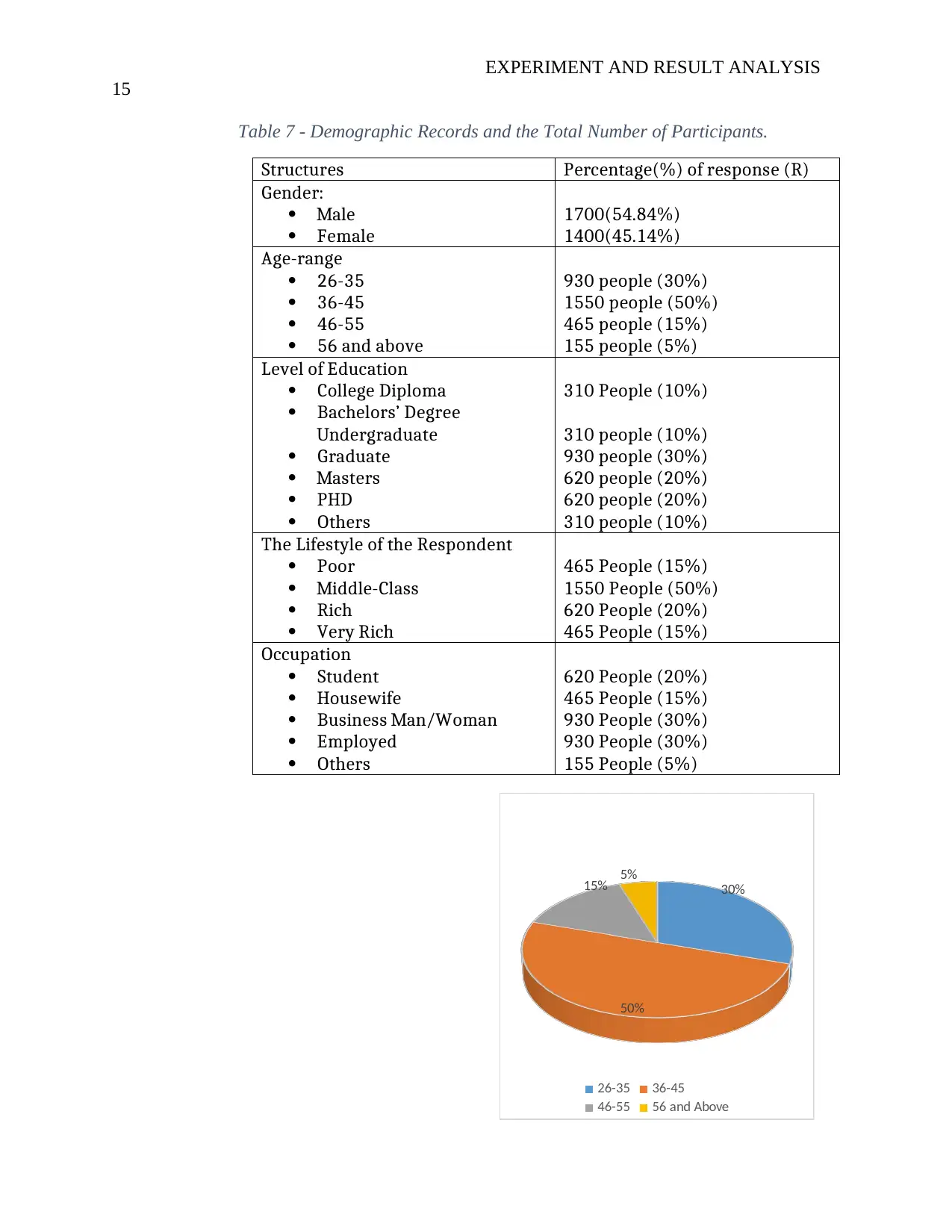
EXPERIMENT AND RESULT ANALYSIS
15
Table 7 - Demographic Records and the Total Number of Participants.
Structures Percentage(%) of response (R)
Gender:
Male
Female
1700(54.84%)
1400(45.14%)
Age-range
26-35
36-45
46-55
56 and above
930 people (30%)
1550 people (50%)
465 people (15%)
155 people (5%)
Level of Education
College Diploma
Bachelors’ Degree
Undergraduate
Graduate
Masters
PHD
Others
310 People (10%)
310 people (10%)
930 people (30%)
620 people (20%)
620 people (20%)
310 people (10%)
The Lifestyle of the Respondent
Poor
Middle-Class
Rich
Very Rich
465 People (15%)
1550 People (50%)
620 People (20%)
465 People (15%)
Occupation
Student
Housewife
Business Man/Woman
Employed
Others
620 People (20%)
465 People (15%)
930 People (30%)
930 People (30%)
155 People (5%)
30%
50%
15% 5%
26-35 36-45
46-55 56 and Above
15
Table 7 - Demographic Records and the Total Number of Participants.
Structures Percentage(%) of response (R)
Gender:
Male
Female
1700(54.84%)
1400(45.14%)
Age-range
26-35
36-45
46-55
56 and above
930 people (30%)
1550 people (50%)
465 people (15%)
155 people (5%)
Level of Education
College Diploma
Bachelors’ Degree
Undergraduate
Graduate
Masters
PHD
Others
310 People (10%)
310 people (10%)
930 people (30%)
620 people (20%)
620 people (20%)
310 people (10%)
The Lifestyle of the Respondent
Poor
Middle-Class
Rich
Very Rich
465 People (15%)
1550 People (50%)
620 People (20%)
465 People (15%)
Occupation
Student
Housewife
Business Man/Woman
Employed
Others
620 People (20%)
465 People (15%)
930 People (30%)
930 People (30%)
155 People (5%)
30%
50%
15% 5%
26-35 36-45
46-55 56 and Above
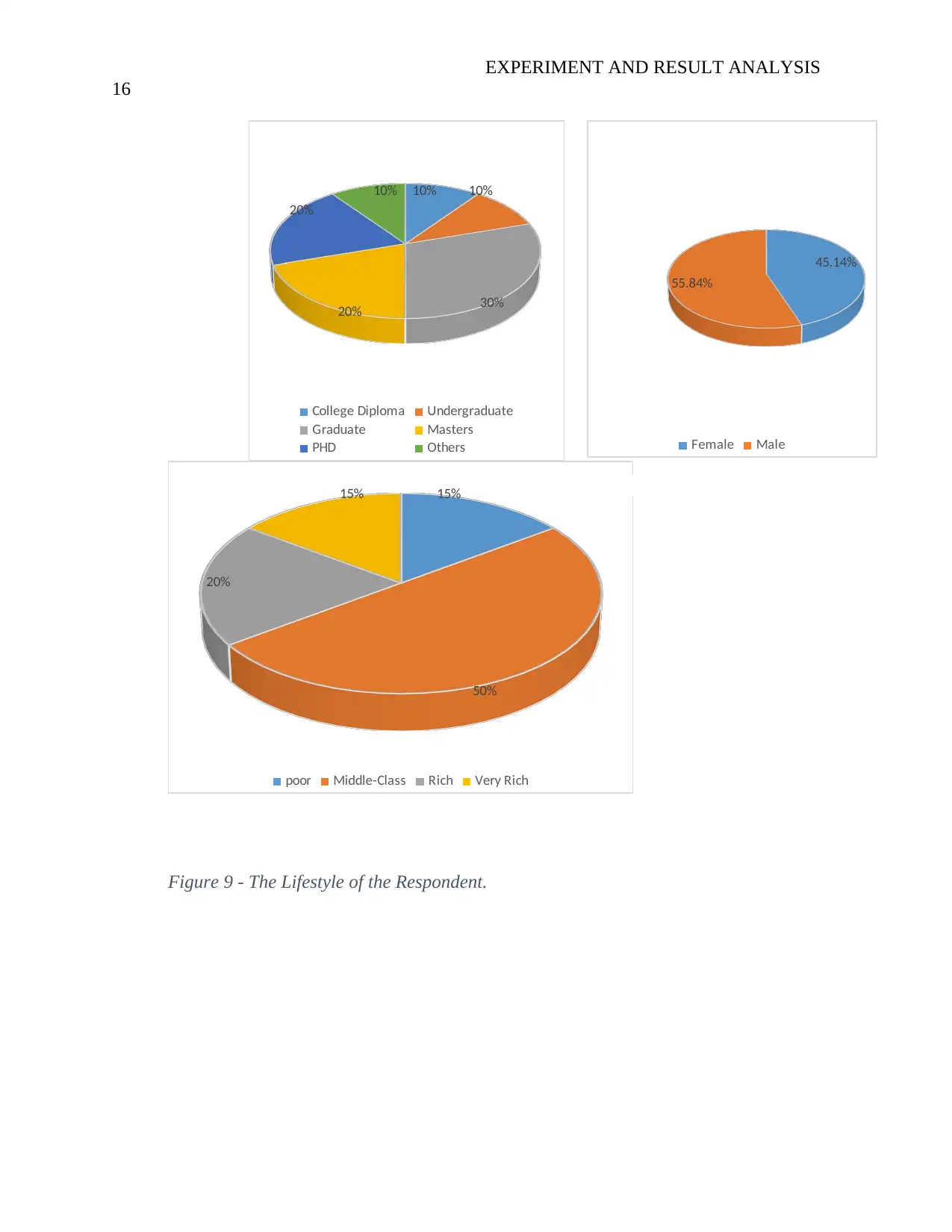
EXPERIMENT AND RESULT ANALYSIS
16
15%
50%
20%
15%
poor Middle-Class Rich Very Rich
Figure 9 - The Lifestyle of the Respondent.
45.14%
55.84%
Female Male
10% 10%
30%
20%
20%
10%
College Diploma Undergraduate
Graduate Masters
PHD Others
16
15%
50%
20%
15%
poor Middle-Class Rich Very Rich
Figure 9 - The Lifestyle of the Respondent.
45.14%
55.84%
Female Male
10% 10%
30%
20%
20%
10%
College Diploma Undergraduate
Graduate Masters
PHD Others
Secure Best Marks with AI Grader
Need help grading? Try our AI Grader for instant feedback on your assignments.
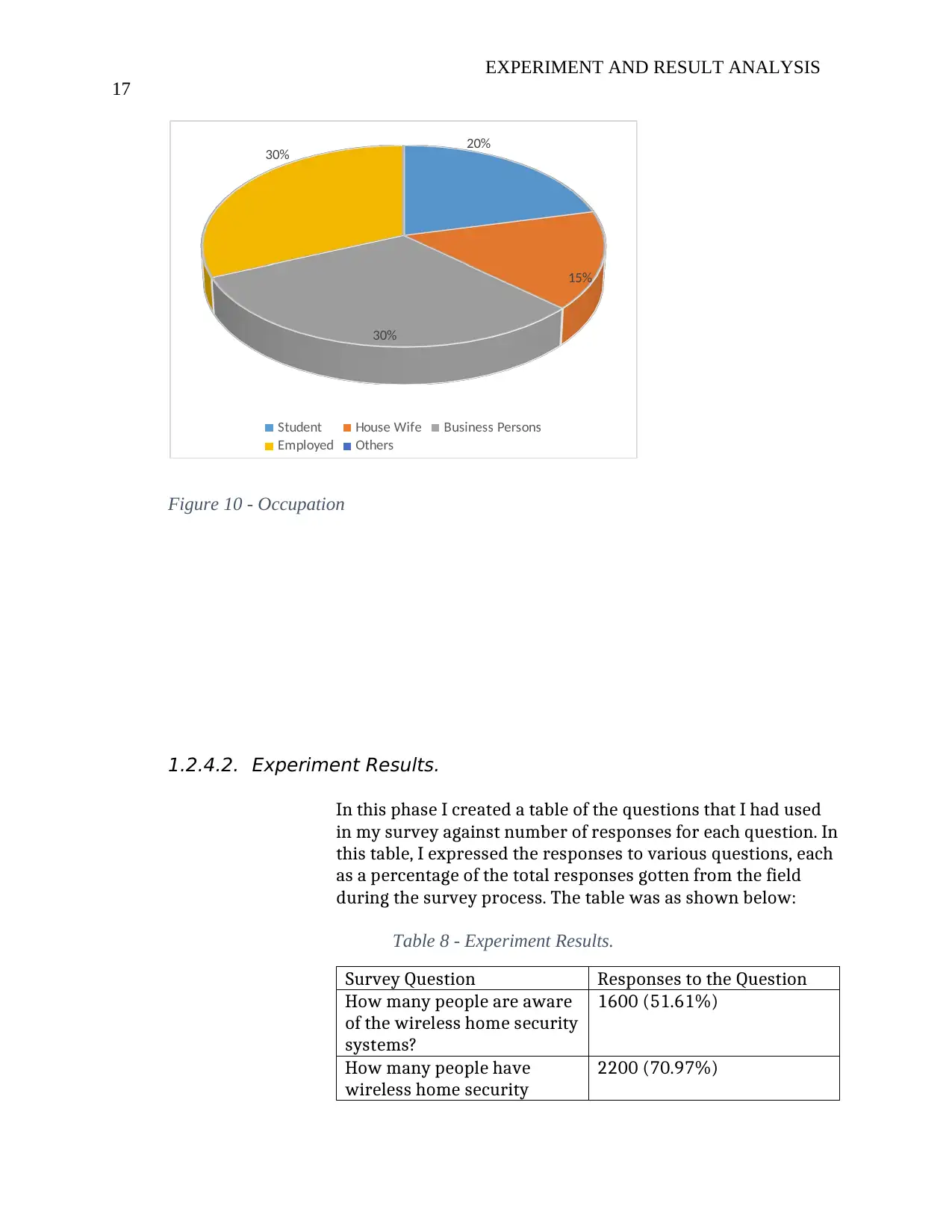
EXPERIMENT AND RESULT ANALYSIS
17
20%
15%
30%
30%
Student House Wife Business Persons
Employed Others
Figure 10 - Occupation
1.2.4.2. Experiment Results.
In this phase I created a table of the questions that I had used
in my survey against number of responses for each question. In
this table, I expressed the responses to various questions, each
as a percentage of the total responses gotten from the field
during the survey process. The table was as shown below:
Table 8 - Experiment Results.
Survey Question Responses to the Question
How many people are aware
of the wireless home security
systems?
1600 (51.61%)
How many people have
wireless home security
2200 (70.97%)
17
20%
15%
30%
30%
Student House Wife Business Persons
Employed Others
Figure 10 - Occupation
1.2.4.2. Experiment Results.
In this phase I created a table of the questions that I had used
in my survey against number of responses for each question. In
this table, I expressed the responses to various questions, each
as a percentage of the total responses gotten from the field
during the survey process. The table was as shown below:
Table 8 - Experiment Results.
Survey Question Responses to the Question
How many people are aware
of the wireless home security
systems?
1600 (51.61%)
How many people have
wireless home security
2200 (70.97%)
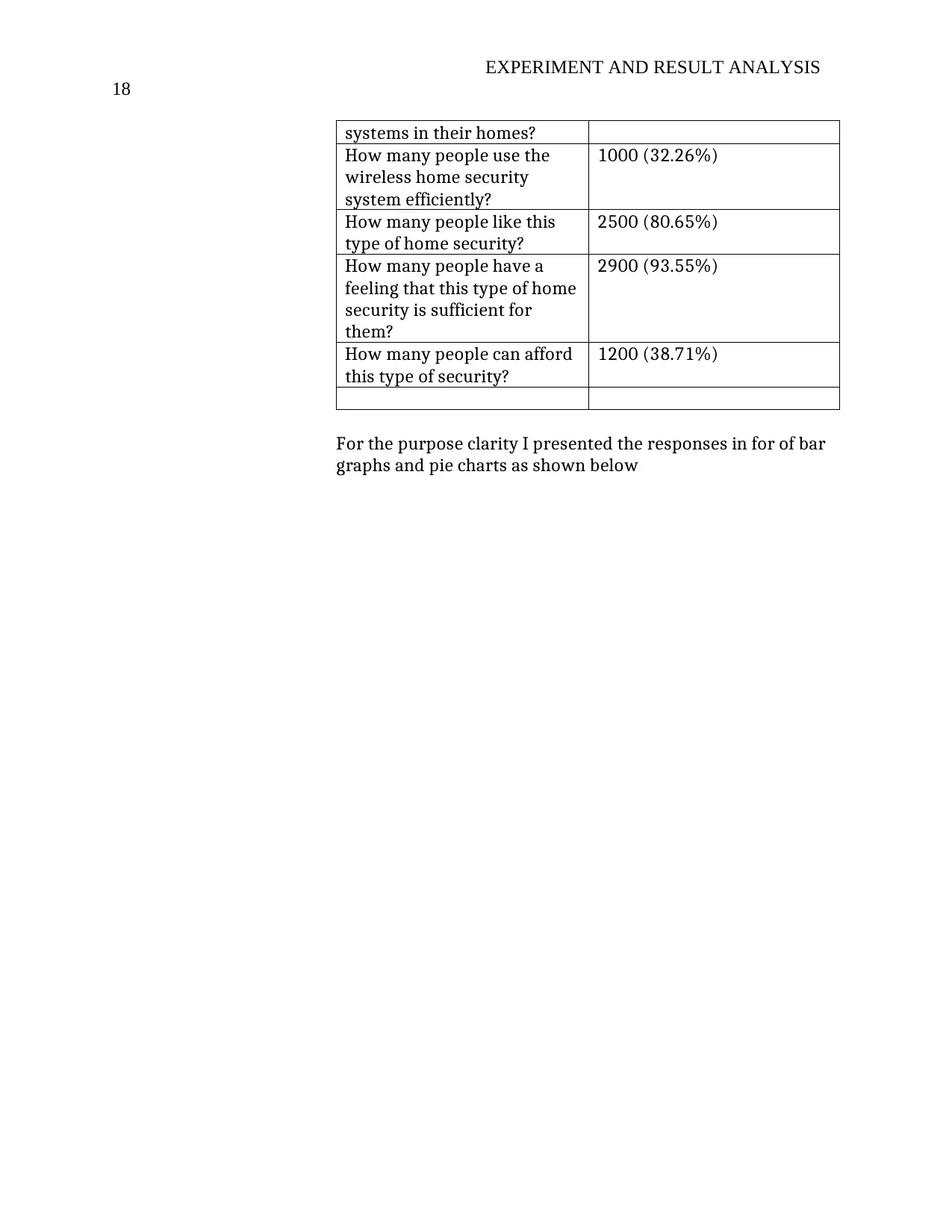
EXPERIMENT AND RESULT ANALYSIS
18
systems in their homes?
How many people use the
wireless home security
system efficiently?
1000 (32.26%)
How many people like this
type of home security?
2500 (80.65%)
How many people have a
feeling that this type of home
security is sufficient for
them?
2900 (93.55%)
How many people can afford
this type of security?
1200 (38.71%)
For the purpose clarity I presented the responses in for of bar
graphs and pie charts as shown below
18
systems in their homes?
How many people use the
wireless home security
system efficiently?
1000 (32.26%)
How many people like this
type of home security?
2500 (80.65%)
How many people have a
feeling that this type of home
security is sufficient for
them?
2900 (93.55%)
How many people can afford
this type of security?
1200 (38.71%)
For the purpose clarity I presented the responses in for of bar
graphs and pie charts as shown below
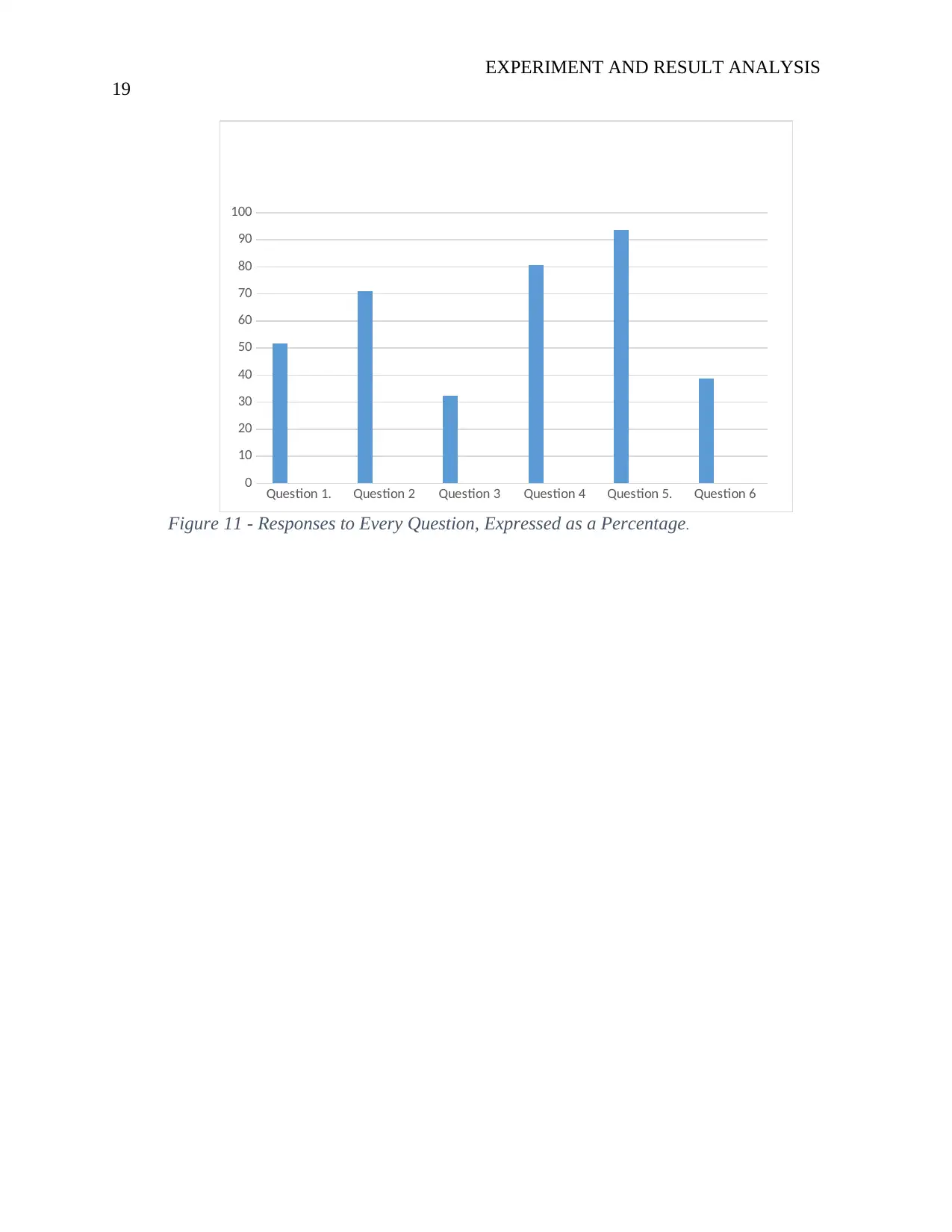
EXPERIMENT AND RESULT ANALYSIS
19
Question 1. Question 2 Question 3 Question 4 Question 5. Question 6
0
10
20
30
40
50
60
70
80
90
100
Figure 11 - Responses to Every Question, Expressed as a Percentage.
19
Question 1. Question 2 Question 3 Question 4 Question 5. Question 6
0
10
20
30
40
50
60
70
80
90
100
Figure 11 - Responses to Every Question, Expressed as a Percentage.
Paraphrase This Document
Need a fresh take? Get an instant paraphrase of this document with our AI Paraphraser
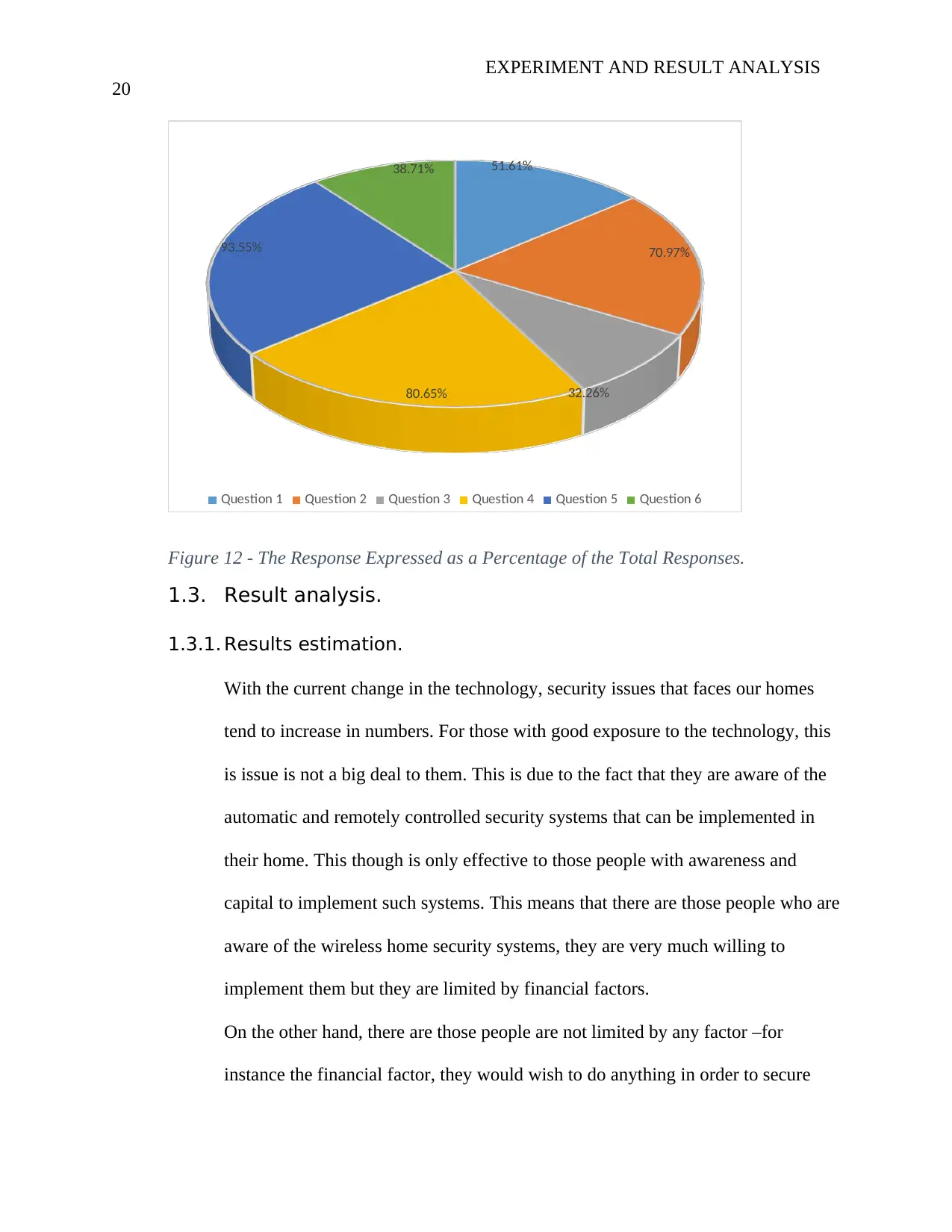
EXPERIMENT AND RESULT ANALYSIS
20
51.61%
70.97%
32.26%80.65%
93.55%
38.71%
Question 1 Question 2 Question 3 Question 4 Question 5 Question 6
Figure 12 - The Response Expressed as a Percentage of the Total Responses.
1.3. Result analysis.
1.3.1. Results estimation.
With the current change in the technology, security issues that faces our homes
tend to increase in numbers. For those with good exposure to the technology, this
is issue is not a big deal to them. This is due to the fact that they are aware of the
automatic and remotely controlled security systems that can be implemented in
their home. This though is only effective to those people with awareness and
capital to implement such systems. This means that there are those people who are
aware of the wireless home security systems, they are very much willing to
implement them but they are limited by financial factors.
On the other hand, there are those people are not limited by any factor –for
instance the financial factor, they would wish to do anything in order to secure
20
51.61%
70.97%
32.26%80.65%
93.55%
38.71%
Question 1 Question 2 Question 3 Question 4 Question 5 Question 6
Figure 12 - The Response Expressed as a Percentage of the Total Responses.
1.3. Result analysis.
1.3.1. Results estimation.
With the current change in the technology, security issues that faces our homes
tend to increase in numbers. For those with good exposure to the technology, this
is issue is not a big deal to them. This is due to the fact that they are aware of the
automatic and remotely controlled security systems that can be implemented in
their home. This though is only effective to those people with awareness and
capital to implement such systems. This means that there are those people who are
aware of the wireless home security systems, they are very much willing to
implement them but they are limited by financial factors.
On the other hand, there are those people are not limited by any factor –for
instance the financial factor, they would wish to do anything in order to secure
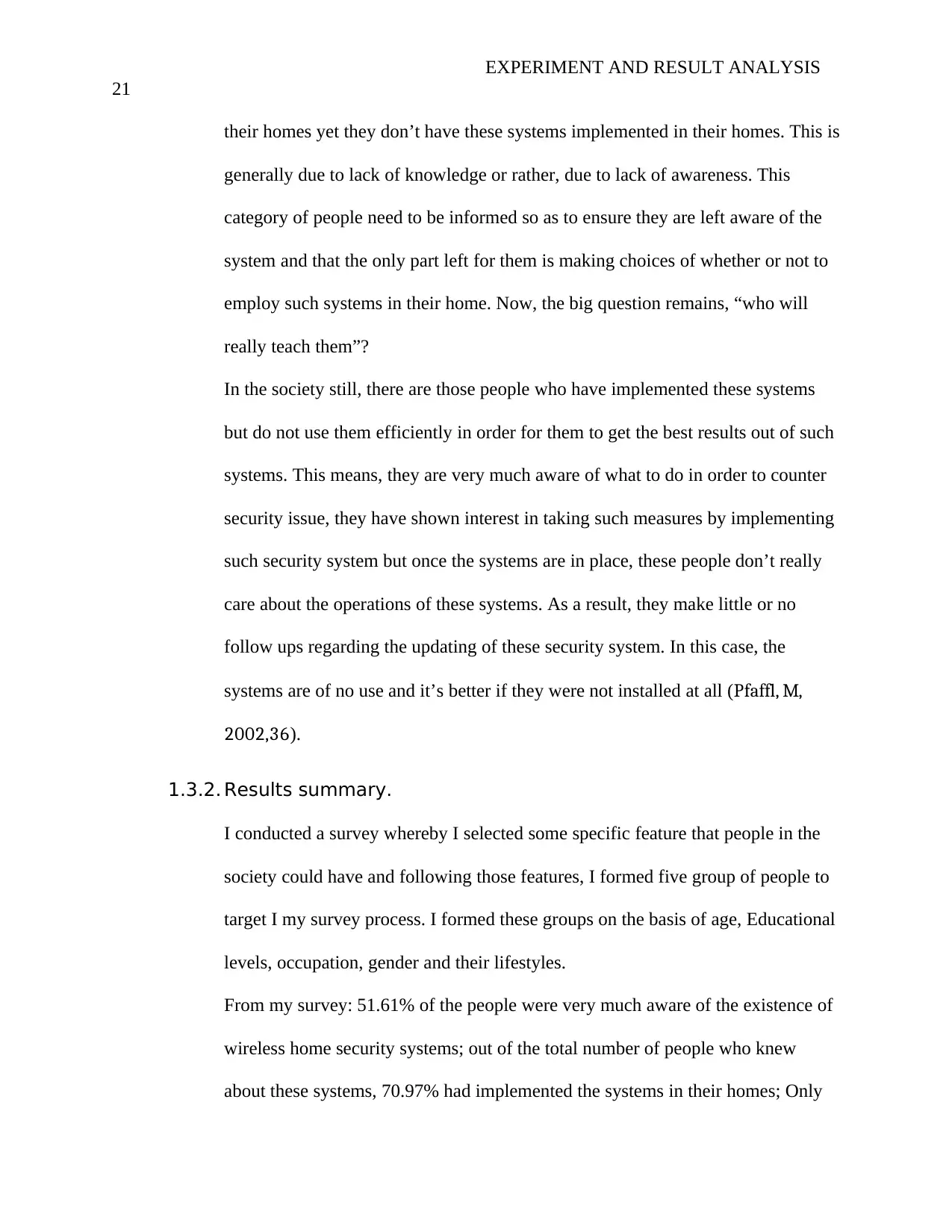
EXPERIMENT AND RESULT ANALYSIS
21
their homes yet they don’t have these systems implemented in their homes. This is
generally due to lack of knowledge or rather, due to lack of awareness. This
category of people need to be informed so as to ensure they are left aware of the
system and that the only part left for them is making choices of whether or not to
employ such systems in their home. Now, the big question remains, “who will
really teach them”?
In the society still, there are those people who have implemented these systems
but do not use them efficiently in order for them to get the best results out of such
systems. This means, they are very much aware of what to do in order to counter
security issue, they have shown interest in taking such measures by implementing
such security system but once the systems are in place, these people don’t really
care about the operations of these systems. As a result, they make little or no
follow ups regarding the updating of these security system. In this case, the
systems are of no use and it’s better if they were not installed at all (Pfaffl, M,
2002,36).
1.3.2. Results summary.
I conducted a survey whereby I selected some specific feature that people in the
society could have and following those features, I formed five group of people to
target I my survey process. I formed these groups on the basis of age, Educational
levels, occupation, gender and their lifestyles.
From my survey: 51.61% of the people were very much aware of the existence of
wireless home security systems; out of the total number of people who knew
about these systems, 70.97% had implemented the systems in their homes; Only
21
their homes yet they don’t have these systems implemented in their homes. This is
generally due to lack of knowledge or rather, due to lack of awareness. This
category of people need to be informed so as to ensure they are left aware of the
system and that the only part left for them is making choices of whether or not to
employ such systems in their home. Now, the big question remains, “who will
really teach them”?
In the society still, there are those people who have implemented these systems
but do not use them efficiently in order for them to get the best results out of such
systems. This means, they are very much aware of what to do in order to counter
security issue, they have shown interest in taking such measures by implementing
such security system but once the systems are in place, these people don’t really
care about the operations of these systems. As a result, they make little or no
follow ups regarding the updating of these security system. In this case, the
systems are of no use and it’s better if they were not installed at all (Pfaffl, M,
2002,36).
1.3.2. Results summary.
I conducted a survey whereby I selected some specific feature that people in the
society could have and following those features, I formed five group of people to
target I my survey process. I formed these groups on the basis of age, Educational
levels, occupation, gender and their lifestyles.
From my survey: 51.61% of the people were very much aware of the existence of
wireless home security systems; out of the total number of people who knew
about these systems, 70.97% had implemented the systems in their homes; Only
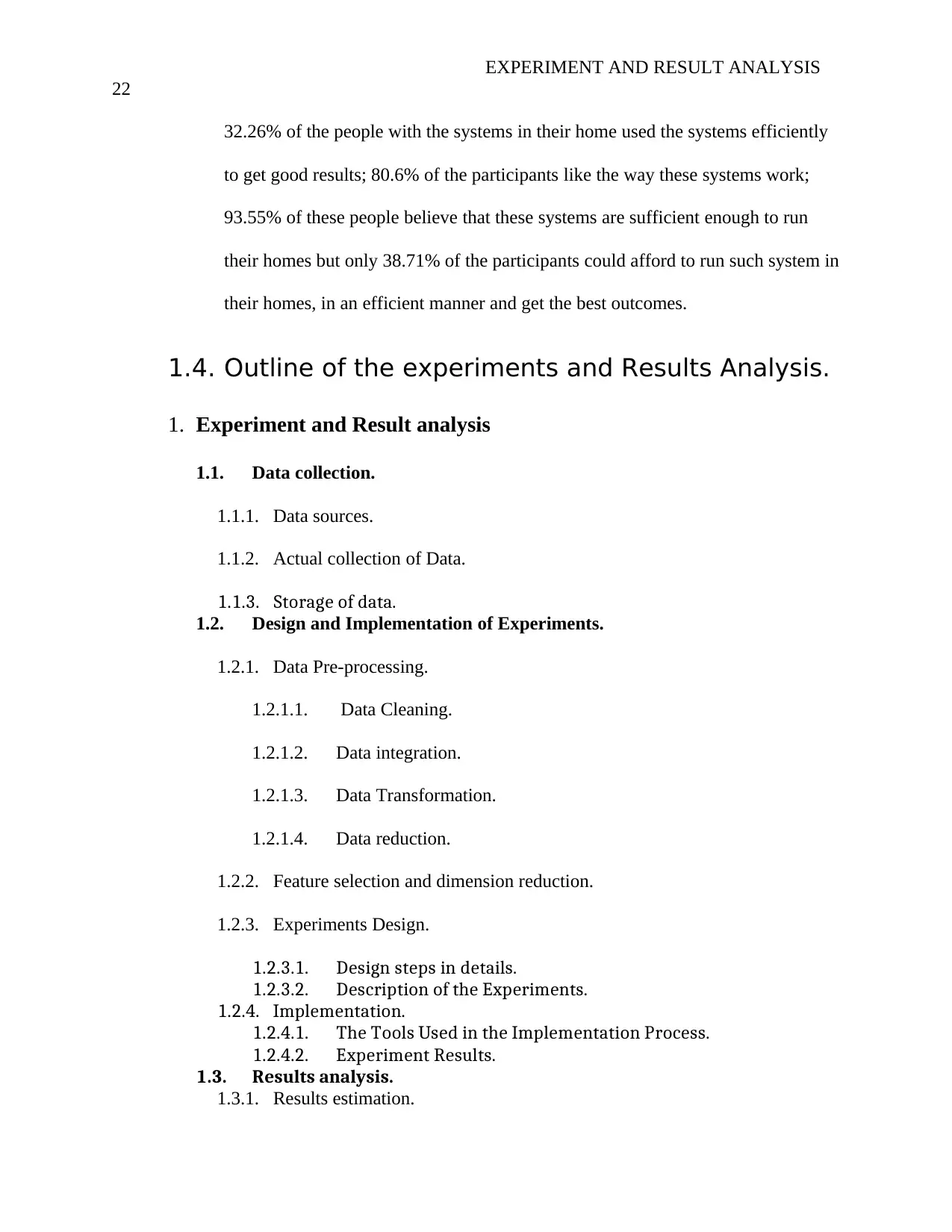
EXPERIMENT AND RESULT ANALYSIS
22
32.26% of the people with the systems in their home used the systems efficiently
to get good results; 80.6% of the participants like the way these systems work;
93.55% of these people believe that these systems are sufficient enough to run
their homes but only 38.71% of the participants could afford to run such system in
their homes, in an efficient manner and get the best outcomes.
1.4. Outline of the experiments and Results Analysis.
1. Experiment and Result analysis
1.1. Data collection.
1.1.1. Data sources.
1.1.2. Actual collection of Data.
1.1.3. Storage of data.
1.2. Design and Implementation of Experiments.
1.2.1. Data Pre-processing.
1.2.1.1. Data Cleaning.
1.2.1.2. Data integration.
1.2.1.3. Data Transformation.
1.2.1.4. Data reduction.
1.2.2. Feature selection and dimension reduction.
1.2.3. Experiments Design.
1.2.3.1. Design steps in details.
1.2.3.2. Description of the Experiments.
1.2.4. Implementation.
1.2.4.1. The Tools Used in the Implementation Process.
1.2.4.2. Experiment Results.
1.3. Results analysis.
1.3.1. Results estimation.
22
32.26% of the people with the systems in their home used the systems efficiently
to get good results; 80.6% of the participants like the way these systems work;
93.55% of these people believe that these systems are sufficient enough to run
their homes but only 38.71% of the participants could afford to run such system in
their homes, in an efficient manner and get the best outcomes.
1.4. Outline of the experiments and Results Analysis.
1. Experiment and Result analysis
1.1. Data collection.
1.1.1. Data sources.
1.1.2. Actual collection of Data.
1.1.3. Storage of data.
1.2. Design and Implementation of Experiments.
1.2.1. Data Pre-processing.
1.2.1.1. Data Cleaning.
1.2.1.2. Data integration.
1.2.1.3. Data Transformation.
1.2.1.4. Data reduction.
1.2.2. Feature selection and dimension reduction.
1.2.3. Experiments Design.
1.2.3.1. Design steps in details.
1.2.3.2. Description of the Experiments.
1.2.4. Implementation.
1.2.4.1. The Tools Used in the Implementation Process.
1.2.4.2. Experiment Results.
1.3. Results analysis.
1.3.1. Results estimation.
Secure Best Marks with AI Grader
Need help grading? Try our AI Grader for instant feedback on your assignments.
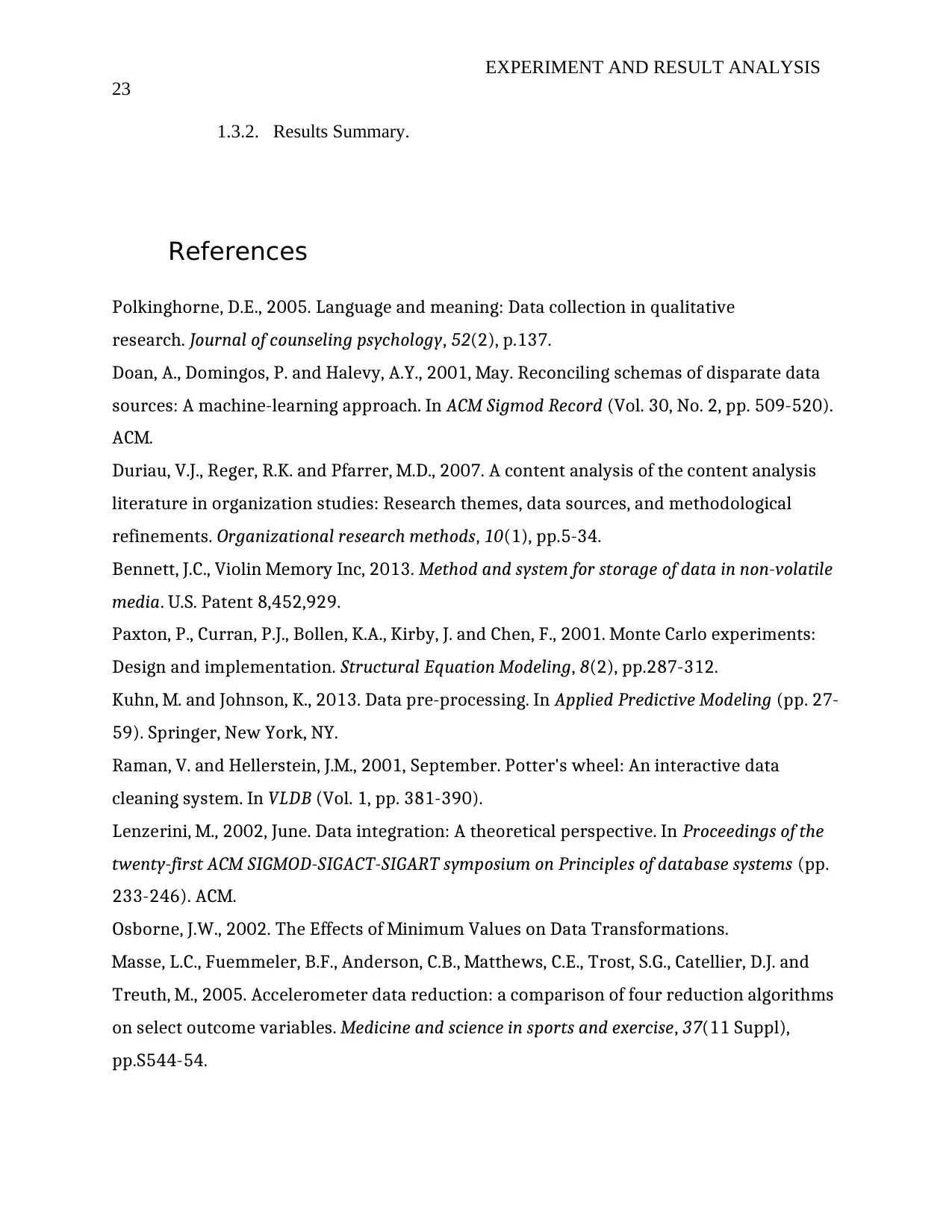
EXPERIMENT AND RESULT ANALYSIS
23
1.3.2. Results Summary.
References
Polkinghorne, D.E., 2005. Language and meaning: Data collection in qualitative
research. Journal of counseling psychology, 52(2), p.137.
Doan, A., Domingos, P. and Halevy, A.Y., 2001, May. Reconciling schemas of disparate data
sources: A machine-learning approach. In ACM Sigmod Record (Vol. 30, No. 2, pp. 509-520).
ACM.
Duriau, V.J., Reger, R.K. and Pfarrer, M.D., 2007. A content analysis of the content analysis
literature in organization studies: Research themes, data sources, and methodological
refinements. Organizational research methods, 10(1), pp.5-34.
Bennett, J.C., Violin Memory Inc, 2013. Method and system for storage of data in non-volatile
media. U.S. Patent 8,452,929.
Paxton, P., Curran, P.J., Bollen, K.A., Kirby, J. and Chen, F., 2001. Monte Carlo experiments:
Design and implementation. Structural Equation Modeling, 8(2), pp.287-312.
Kuhn, M. and Johnson, K., 2013. Data pre-processing. In Applied Predictive Modeling (pp. 27-
59). Springer, New York, NY.
Raman, V. and Hellerstein, J.M., 2001, September. Potter's wheel: An interactive data
cleaning system. In VLDB (Vol. 1, pp. 381-390).
Lenzerini, M., 2002, June. Data integration: A theoretical perspective. In Proceedings of the
twenty-first ACM SIGMOD-SIGACT-SIGART symposium on Principles of database systems (pp.
233-246). ACM.
Osborne, J.W., 2002. The Effects of Minimum Values on Data Transformations.
Masse, L.C., Fuemmeler, B.F., Anderson, C.B., Matthews, C.E., Trost, S.G., Catellier, D.J. and
Treuth, M., 2005. Accelerometer data reduction: a comparison of four reduction algorithms
on select outcome variables. Medicine and science in sports and exercise, 37(11 Suppl),
pp.S544-54.
23
1.3.2. Results Summary.
References
Polkinghorne, D.E., 2005. Language and meaning: Data collection in qualitative
research. Journal of counseling psychology, 52(2), p.137.
Doan, A., Domingos, P. and Halevy, A.Y., 2001, May. Reconciling schemas of disparate data
sources: A machine-learning approach. In ACM Sigmod Record (Vol. 30, No. 2, pp. 509-520).
ACM.
Duriau, V.J., Reger, R.K. and Pfarrer, M.D., 2007. A content analysis of the content analysis
literature in organization studies: Research themes, data sources, and methodological
refinements. Organizational research methods, 10(1), pp.5-34.
Bennett, J.C., Violin Memory Inc, 2013. Method and system for storage of data in non-volatile
media. U.S. Patent 8,452,929.
Paxton, P., Curran, P.J., Bollen, K.A., Kirby, J. and Chen, F., 2001. Monte Carlo experiments:
Design and implementation. Structural Equation Modeling, 8(2), pp.287-312.
Kuhn, M. and Johnson, K., 2013. Data pre-processing. In Applied Predictive Modeling (pp. 27-
59). Springer, New York, NY.
Raman, V. and Hellerstein, J.M., 2001, September. Potter's wheel: An interactive data
cleaning system. In VLDB (Vol. 1, pp. 381-390).
Lenzerini, M., 2002, June. Data integration: A theoretical perspective. In Proceedings of the
twenty-first ACM SIGMOD-SIGACT-SIGART symposium on Principles of database systems (pp.
233-246). ACM.
Osborne, J.W., 2002. The Effects of Minimum Values on Data Transformations.
Masse, L.C., Fuemmeler, B.F., Anderson, C.B., Matthews, C.E., Trost, S.G., Catellier, D.J. and
Treuth, M., 2005. Accelerometer data reduction: a comparison of four reduction algorithms
on select outcome variables. Medicine and science in sports and exercise, 37(11 Suppl),
pp.S544-54.
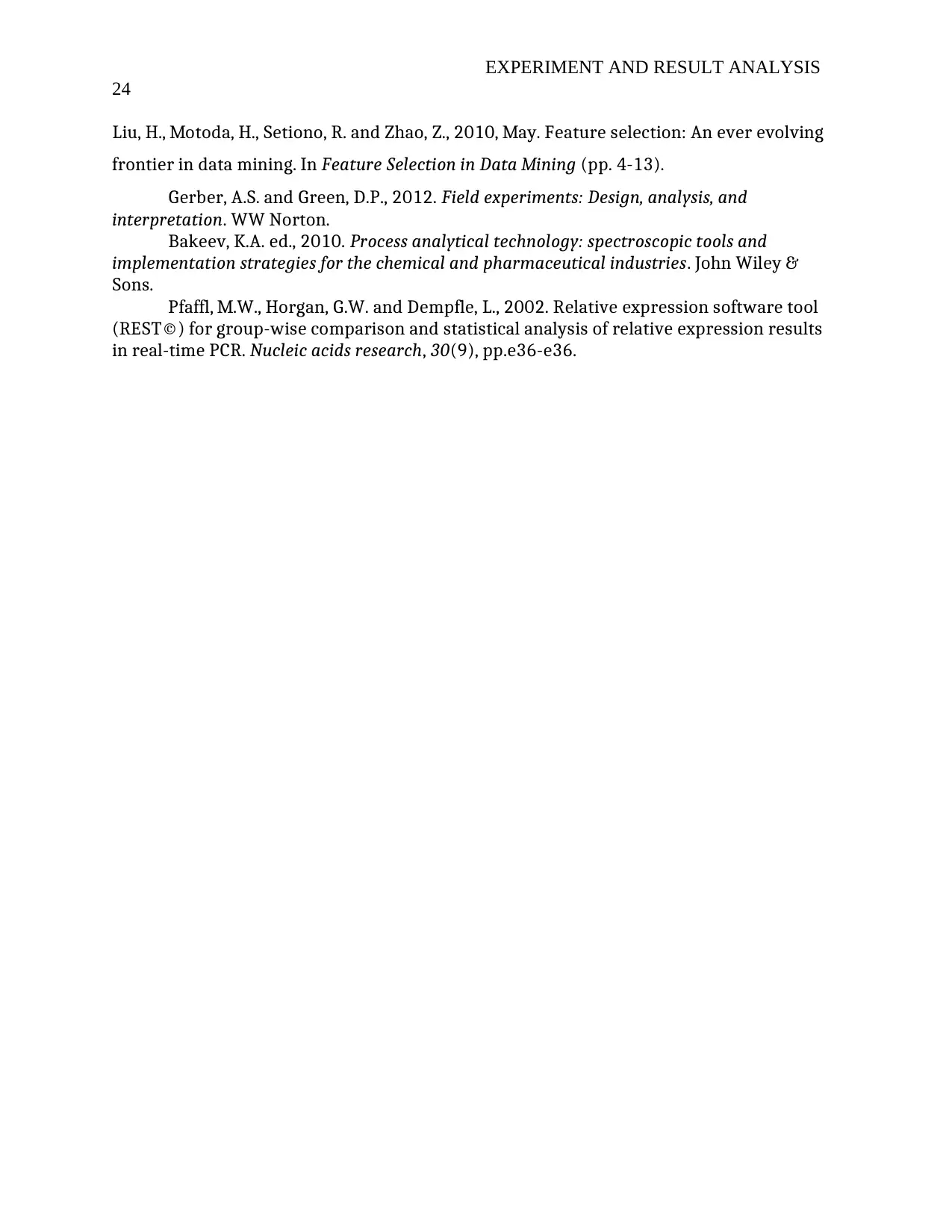
EXPERIMENT AND RESULT ANALYSIS
24
Liu, H., Motoda, H., Setiono, R. and Zhao, Z., 2010, May. Feature selection: An ever evolving
frontier in data mining. In Feature Selection in Data Mining (pp. 4-13).
Gerber, A.S. and Green, D.P., 2012. Field experiments: Design, analysis, and
interpretation. WW Norton.
Bakeev, K.A. ed., 2010. Process analytical technology: spectroscopic tools and
implementation strategies for the chemical and pharmaceutical industries. John Wiley &
Sons.
Pfaffl, M.W., Horgan, G.W. and Dempfle, L., 2002. Relative expression software tool
(REST©) for group-wise comparison and statistical analysis of relative expression results
in real-time PCR. Nucleic acids research, 30(9), pp.e36-e36.
24
Liu, H., Motoda, H., Setiono, R. and Zhao, Z., 2010, May. Feature selection: An ever evolving
frontier in data mining. In Feature Selection in Data Mining (pp. 4-13).
Gerber, A.S. and Green, D.P., 2012. Field experiments: Design, analysis, and
interpretation. WW Norton.
Bakeev, K.A. ed., 2010. Process analytical technology: spectroscopic tools and
implementation strategies for the chemical and pharmaceutical industries. John Wiley &
Sons.
Pfaffl, M.W., Horgan, G.W. and Dempfle, L., 2002. Relative expression software tool
(REST©) for group-wise comparison and statistical analysis of relative expression results
in real-time PCR. Nucleic acids research, 30(9), pp.e36-e36.
1 out of 24
Related Documents
Your All-in-One AI-Powered Toolkit for Academic Success.
+13062052269
info@desklib.com
Available 24*7 on WhatsApp / Email
![[object Object]](/_next/static/media/star-bottom.7253800d.svg)
Unlock your academic potential
© 2024 | Zucol Services PVT LTD | All rights reserved.





